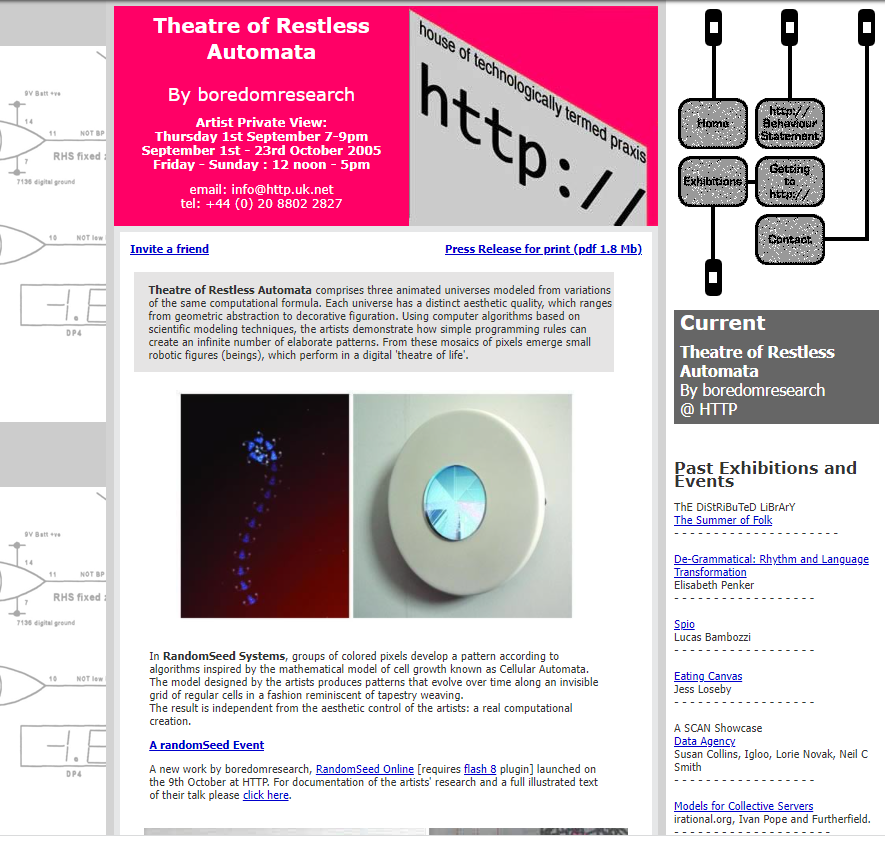



Annie Abrahams will be working as an Artist in Residence at HTTP Gallery in January 2010. During the residency Abrahams will work on the production of three new works including live telematic and online networked performances to be presented as part of If not you not me at HTTP Gallery in February 2010.
Annie Abrahams (b. NL 1954, lives and works FR) is an internationally regarded pioneer of networked performance art. If not you not me at HTTP Gallery in London was the first solo exhibition of her work in the UK. While social networking sites make us think of communication as clean and transparent, Annie Abrahams creates an Internet of feeling – of agitation, collusion, ardour and apprehension.
The residency and exhibition are conceived in connection with Furtherfield’s Rich Networking project interrogating the transparency of communication, artistic collaboration and sociability through digital networks; and as part of Furtherfield’s three-year Media Art Ecologies programme which foregrounds practices sharing an ecological approach – an interest in the interrelation of technological and natural processes: beings and things, individuals and multitudes, matter and patterns.
Working with simple interfaces, disruptions in data-flow and carefully crafted instructions, Abrahams sensitises participants and audiences to glitches in communication and invites them to experience and reflect on different ways of being together in a machine-mediated world. The exhibition asks how we deal with the tensions of collaboration and physical separation as we negotiate relationships through video imagery, computer software and digital networks.
Annie Abrahams was born to a farming family in a rural village in the Netherlands. She obtained a doctorate in biology in 1978 and found that her observations of monkeys inspired curiosity about human interactions. After leaving an academic post, she trained as an artist and moved to France, where she became interested in using computers to construct and document her painting installations. She began experimenting with networked performance and making art for the Internet in the mid 1990s. Her work has since returned to the questions raised by the monkeys, concentrating on the possibilities and limitations of communication on the Internet. She has performed and shown work extensively in France, including at the Pompidou Centre, Paris, and in many international galleries including among others Espai d’Art Contemporani de Castelló, Spain; the Museum of Contemporary Art, Tokyo; and the Armenian Center for Contemporary Experimental Art, Yerevan; festivals such as the Moscow Film Festival and the International Film Festival of Rotterdam, and on online platforms such as Rhizome.org and Turbulence.
4th-12th December ’09,
Re-opening 8th-30th January ’10
Live performance at 8pm representing a central controversy arising during the project.
Visit the blog http://http.uk.net/diwodarkmountain
We live in a time of social, economic and ecological unravelling. All around us are signs that our whole way of living is already passing into history. – Uncivilisation, The Dark Mountain Manifesto.
The Dark Mountain Project is ‘a new cultural movement for an age of global disruption.’ It aims to ‘question the stories that underpin our failing civilisation, to craft new ones for the age ahead and to write clearly and honestly about our true place in the world.’ Do It With Others (DIWO) at the Dark Mountain, a mail-art project at HTTP Gallery, is a cultural collaboration for this age. “Uncivilisation,” the Dark Mountain Manifesto, calls for a cultural response to our current predicament. Its challenge was offered to network-minded artists, technologists, writers and activists as a provocation – to work together to re-envision the narratives and infrastructures that govern our relationships with the natural world and how they might be unravelled and rewoven to reconfigure our place in it. As “Uncivilisation” concludes, ‘the end of the world as we know it is not the end of the world full stop.’
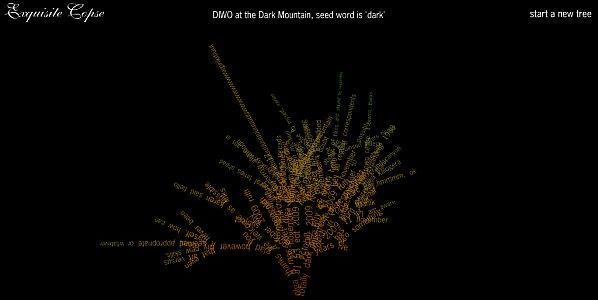
Artists, technologists, writers, activists and all other living beings were invited to correspond with each other across physical and digital mail networks, and the exhibition at HTTP presents the results of this process. These have been gathered and the presentation devised during an Open Curation event involving collaborators in real and virtual space. Transmissions to be shown in the exhibition include collaborative image threads, net artworks, digital videos, drawings, paintings on wall and paper, sound works, and the full text of the discussion generated on the NetBehaviour list presented in numerous forms. The opening will also feature a performance representing a central controversy arising during the project. The exhibition offers new myths and maps for future uncivilisation at HTTP Gallery.
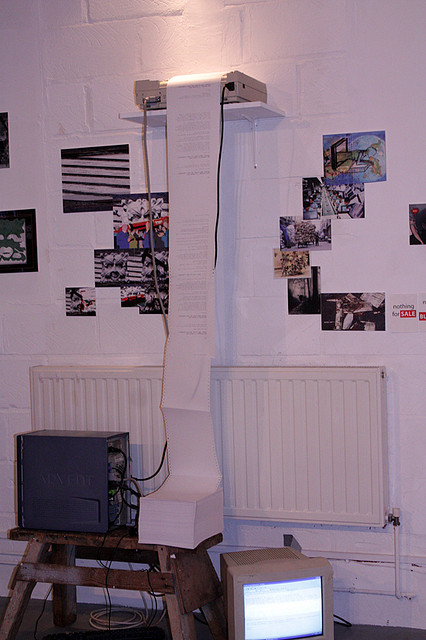
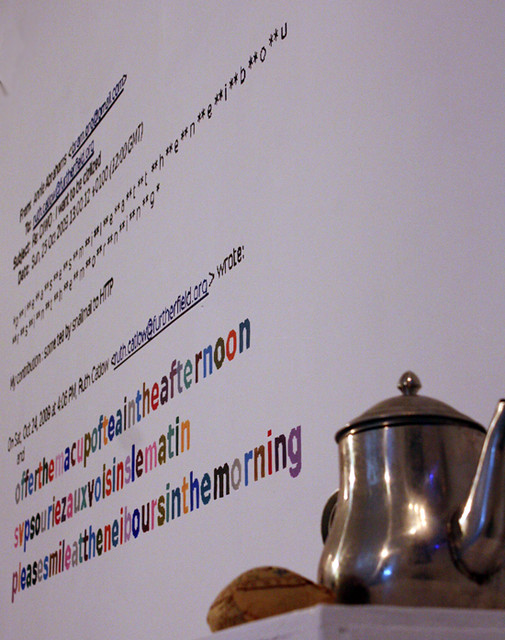
The Exhibition features contributions by:
Alan Sondheim; Alessandro Ludovico; Andreas Jacobs; Andrei Tisma; Annie Abrahams; Antonio Dias; Antonio Roberts; Arn; Bob Catchpole; Brian Gibson; Crowe; Curt Cloninger; Dan Walwin; Dave Miller; Dion Laurent; Dougald Hine; Edward Picot; Fung-Lin Hall; Helen Varley Jamieson; Karen Blissett; James Morris; John Criscitello; J. Trautwein; Lauren A Wright; Lucille C.; Maja Kalogera; Manik; Marc Garrett; Mark Cooley; Mark Hancock; Mez Breeze; Michael Szpakowski; Neil Jenkins; Olga Panades; Pall Thayer; Peter Gomes; Pim Peterse; Renee Turner; Paulo R. C. Barros; Riccardo Mantelli; Rhea Myers; Ruth Catlow; Simon Biggs; Simon Longo; Steven Read; Stuart; Valentin J.-A.; Vittore Baroni; Wolfgang Spaeth.
This is the second Do It With Others (DIWO) E-Mail-Art project initiated by Furtherfield. The first DIWO experiment in 2007 extended the Do-It-Yourself ethos of early net art, characterised by curiosity, activism and precision, towards a more collaborative approach, using the Internet as an experimental artistic medium and distribution system to foment grass-roots creativity.
Do It With Others at the Dark Mountain is a collaborative project by Furtherfield and The Dark Mountain Project.
+ More about The Dark Mountain Project
The Dark Mountain Project is curated by Paul Kingsnorth and Dougald Hine.
Paul is the author of One No, Many Yeses and Real England. He was deputy editor of The Ecologist between 1999 and 2001. His first poetry collection, Kidland, is forthcoming from Salmon Poetry.
Dougald writes the blog “Changing the World (and other excuses for not getting a proper job).” He is a former BBC journalist and co-founder of the School of Everything and has written for and edited various online and offline magazines.
This project is part of Furtherfield.org’s three-year Media Art Ecologies programme, which aims to provide opportunities for critical debate, exchange and participation in emerging ecological media art practices and the theoretical, political and social contexts they engage. HTTP Gallery is Furtherfield.org’s dedicated space for media art. Furtherfield provides platforms for creating, viewing, discussing and learning about experimental practices in art and technology. Furtherfield.org and HTTP Gallery are supported by Arts Council England, London.
DIWO At the Dark Mountain: A Mail-Art project across physical and digital networks in collaboration with the Dark Mountain Project; to question the stories that underpin our failing civilisation and to craft new ones for the age ahead.
Join us for the DIWO co-curation event 12-3pm at HTTP Gallery Friday 27 November 2010 and Online here http://www.livestream.com/furtherfield. Log on at noon for a 12.15 start.
Join us to view the work and discuss the concepts and approaches explored and make decisions about how the work can best be displayed in the gallery.
From the webpage you will be able see and hear what we’re doing in the gallery and contribute to the discussion via instant messaging.
If you experience any problems, email aleATfurtherfieldDOTorg.
Stanza, Ximena Alarcón, Peter Cusack, Furtherfield.org, Chris Joseph, Francisco Lopez, Katharine Norman, Aki Pasoulas, Pedro Rebelo, Ambrose Seddon
View Sound Ecologies commission by Chris Joseph.
A day of presentations, participatory workshops and informal performance around themes of urban sound, networked sound, locative media and acoustic ecology the relationship between living beings and their environment, as mediated by sound. Featuring Furtherfield.org (Ruth Catlow and Marc Garrett), and guest speakers Stanza, Peter Cusack, Ximena Alarcón and Pedro Rebelo.
The event is free, and open to anyone interested, including musicians, artists, curators, technologists; ecologically inclined thinkers, makers and doers of all kinds.
BOOKING IS ESSENTIAL
Space is limited. Please reserve your place here.
We hope to offer wireless access. If you wish to have wireless access you MUST email in advance your name, computer model and MAC address to Katharine Norman at Katharine.norman@city.ac.uk by 7 November 2009.
We invite you to contribute sound and AV media on the theme of ‘urban sound’ to VisitorsStudio for incorporation into the mix by participants on the day.
Bring headphones to take part in the VisitorsStudio workshop.
Wear comfortable (and quiet!) clothing and shoes for the soundwalk, and be prepared for rain.
Maps and information about getting to City University London: the Performance Space and Lab are on the lower ground floor of the College Building, entrance on St John Street.
View more details of the day’s events here.
SOUND ECOLOGIES: LISTENING IN THE CITY is a partnership event funded by LCACE convened by Katharine Norman, Department of Music, City University London and Furtherfield.org
Ximena Alarcón – Sounding Underground: Linking urban soundscapes via commuters memories.
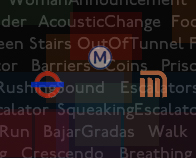
Ximena’s practice-led research project studied commuter’s perceptions towards their daily life soundscape in underground public transport systems, taking the case studies of Paris and México City as counterparts of the London Underground. The results are the basis for the creation of a score that becomes an interactive user’s interface in an Internet-based sonic environment: Sounding Underground. Interactivity, understood as “Listening and Remembering”, has taken two main forms: navigation, including written feedback, on the web, and a off-line networked improvisation for groups of four commuters who used their voices to express memories. This approach strives to make commuters contributors in the creation of these environments, and furthermore performers and narrators of their commuting experience. Ximena Alarcón, born in Bogotá, Colombia, in 1972, is a multimedia artist specialising in soundscape, collective memory and interactivity. She completed her PhD in Music, Technology and Innovation at De Montfort University in 2007 with a work entitled An Interactive Sonic Environment derived from commuters’ memories of soundscape: a case study of the London Underground. For the last two years she has been expanding and implementing this work at De Montfort’s Institute of Creative Technologies (IOCT), thanks to an Early Career Fellowship award given by The Leverhulme Trust. One of her objectives is to find a balance between artistic and socially based work within specific soundscapes that involve virtual and real migrations, and with people who are usually outside the artistic scene, doing so by creating narratives in new media.
Peter Cusack
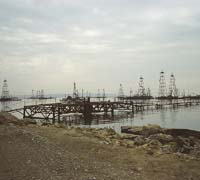
Peter’s presentation will focus on the ‘Your Favourite London Sound’ project that aims to discover what Londoners find positive in their city’s soundscape, an idea that has been repeated in other world cities including Beijing and Chicago. Peter is based in London where he works as a sound artist, musician and environmental recordist with a special interest in environmental sound and acoustic ecology. Projects move from community arts to research into the contribution of sound to our senses of place to recordings that document areas of special sonic interest, e.g. Lake Baikal, Siberia, and Xinjiang, China’s most western province. Recently involved in ‘Sound & the City’ the British Council sound art project in Beijing 2005. His current project ‘Sounds From Dangerous Places’ examines the soundscapes of sites of major environmental damage, e.g. Chernobyl, the Azerbaijan oil fields, controversial dams on the Tigris and Euphratees river systems in south east Turkey. He produced ‘Vermilion Sounds’ a monthly environmental sound program on ResonanceFM radio, London, and is a Senior Lecturer in ‘Sound Arts & Design’ at the London College of Communication. Recently appointed research fellow on the Engineering & Physical Sciences Research Council’s multidisciplinary ‘Positive Soundscapes Project’.As a musician he tours regularly at home and abroad. Musical collaborators include Clive Bell, Nic Collins, Alterations, Chris Cutler, Max Eastley, Annette Krebs and Viv Corringham.
Furtherfield.org – Media Art Ecologies
Furtherfield.org have worked with Katharine Norman at City University London to develop SOUND ECOLOGIES: LISTENING IN THE CITY. Furtherfield.org supports experimental practices at the intersection of art, technology and social change. They are currently working to increase opportunities for art making and appreciation, critical debate, exchange and participation in emerging ecological media art practices, and the theoretical, political and social contexts they engage.
Chris Joseph – digital writer and artist
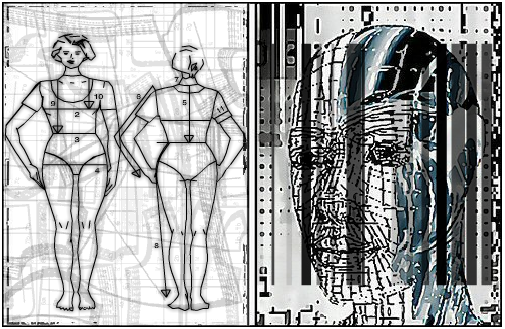
Chris Joseph has been commissioned to provide a visual interpretation of the day’s themes (watch this space!)
Chris Joseph creates electronic literature, multimedia and interactive art, which may include text, images and video, sounds, music and reader/viewer participation. His ongoing projects include Flight Paths, a ‘networked novel’; Inanimate Alice, a series of interactive multimedia stories; and remixworx, a collaborative digital remixing community. Other projects are NRG, a bicycle-powered interactive multimedia installation around the themes of sustainable energy, and The Breathing Wall, a digital novel that responds to the reader’s breathing rate. From September 2006 until September 2008 he was the first Digital Writer in Residence at the Institute of Creative Technologies in De Montfort University, Leicester, UK.
Francisco Lopez – Buildings (New York)
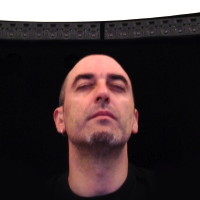
Francisco López is a major international figure in the sound art and experimental music scene. Over the past 30 years he has developed an absolutely personal and iconoclastic sonic universe based on a profound listening of the world. Destroying boundaries between industrial sounds and wilderness sound environments, shifting with passion from the limits of perception to the most dreadful abyss of sonic power, proposing a blind, profound and transcendental listening, freed from the imperatives of knowledge and open to sensory and spiritual expansion. He has realized hundreds of concerts, projects with field recordings, workshops and sound installations in 60 countries of the five continents. His extensive catalog of sound pieces (with live and studio collaborations with over 100 international artists) has been released by more than 200 record labels worldwide, and he has been awarded three times with honorary mentions at the competition of Ars Electronica Festival.
Review of Buildings (New York).
Katharine Norman – Sound Ecologies
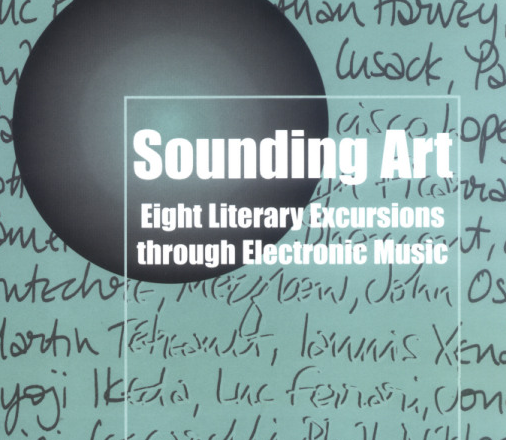
Katharine Norman composes computer and electronic music, often using documentary sound and voice, and increasingly writes texts. Her PhD (Princeton, 1993) focused on documentary sound in sound-based art and she has more recently completed a postgraduate diploma in creative writing and new media. She has various bits of sound art and music and writing on the web, and on CDs – including two solo cds: “London” (NMC label) and “Transparent things” (Metier). Increasingly, she writes about music, in particular electroacoustic and electronic music – Sounding Art: Eight Literary Excursions through Electronic Music, a book of experimental writings on recent electronic music (of many kinds and approaches) was published by Ashgate in 2004. She is currently head of the department of Music at City University London, and has previously taught at Goldsmiths (Music), Simon Fraser University (Communications) and Anglia Ruskin University (English).
Aki Pasoulas – City Soundwalk
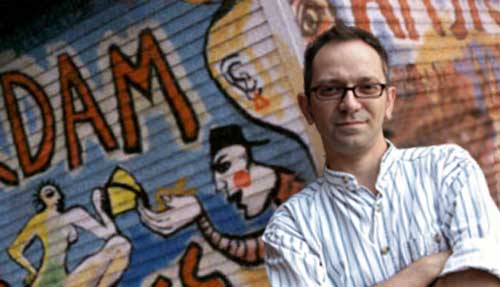
Aki Pasoulas is a London-based composer of electroacoustic and acoustic music. He lectures at the Universities of City London, Middlesex, and the Arts London, and he is finalising his doctoral research at City University London under the supervision of Denis Smalley. Aki’s research project, funded by the Arts and Humanities Research Council (AHRC), investigates the listener’s experience and interpretation of time passing, and the interrelationships among timescales in electroacoustic composition. Further research interests include psychoacoustics, microsound, spatialisation, sound poetry and the use of voice in non-western musics. Aki originally studied and worked as a graphic designer, before embarking into music studies at the Open University and then at Goldsmiths College, University of London.
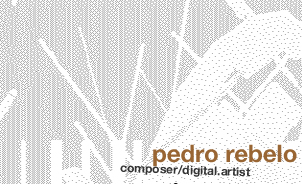
Will present a talk on some recent work linking locative media with network performance. Pedro is a composer/digital artist working in electroacoustic music, digital media and installation. His approach to music making is informed by the use of improvisation and interdisciplinary structures. He has been involved in several collaborative projects with visual artists and has created a large body of work exploring the relationships between architecture and music in creating interactive performance and installation environments. Pedro conducts research in the field of digital media, interactive sound and composition. His writings reflect his approach to design and composition by articulating creative practice in a wider understanding of cultural theory. Pedro was Visiting Professor at Stanford University (2007) and the Music Chair for the 2008 International Computer Music Conference. He has been Director of Research at the Sonic Arts Research Centre and is now Director of Education at the School of Music and Sonic Arts, Queen’s University Belfast.
Ambrose Seddon – City Soundwalk
Ambrose Seddon has a background in rock and electronic pop music. After graduating with a degree in music from Goldsmiths College, University of London, he spent a number of years teaching, while writing, producing and performing in various bands, with releases through a number of independent record labels. He completed a Masters degree in electroacoustic composition at City University, London, in 2004, and now continues his studies at City University as a PhD student, supervised by Denis Smalley. His music has been performed in concert internationally, and has been awarded 1’st prize in the Visiones Sonoras Electroacoustic Music Composition Competition, Mexico, 2006, and the European Composition Prize at the International Computer Music Conference, Copenhagen, 2007.
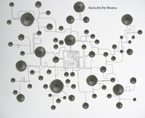
Stanza’s artworks explore artistic and technical opportunities to enable new aesthetic perspectives, experiences and perceptions within context of architecture, data spaces and online environments. His presentation will focus on his online and sonic work in relation to urban and networked spaces. Stanza is a London based British artist who specializes in interactive art, networked spaces, installations and performances. His award winning online projects have been invited for exhibition in digital festivals around the world. Work has been shown at The VeniceBiennale, Tate Britain, The Victoria and Albert Museum. Recipient of Nesta Dreamtime Award, AHRC creative fellowship and numerous prizes. All his artworks can be found at www.stanza.co.uk/
Throughout: LISTENING IN THE CITY. A visual interpretation of the day’s themes by Chris Joseph, digital artist in residence.
Performance Space Foyer
10:00-10:30 WELCOME AND INTRODUCTION
Performance Space, City University London
10:30-13:00 LISTENING IN THE CITY: PANEL PRESENTATIONS AND DISCUSSION
Performance Space
Artistic and research presentations by Stanza, Ximena Alarcón, Peter Cusack and Pedro Rebelo of work with locative media, urban listening, acoustic ecology and networked performance.
13:00-14:00 BUILDINGS (NEW YORK)
Performance Space
A multi-speaker diffusion of Buildings (New York) by Francisco Lopez.
Come in and out, bring your lunch, listen.
14:00-15:30 AFTERNOON WORKSHOP OR SOUNDWALK – All welcome
VISITORSSTUDIO WORKSHOP: URBAN SOUND AND VISION SCAPES
ALG04 (PC lab)
Live AV collaborative mixing led by Marc Garrett, Furtherfield.org (participants please bring headphones).
Places limited.
OR
URBAN SOUNDWALK
Commencing from Performance Space Foyer a City Soundwalk led by Aki Pasoulas and Ambrose Seddon.
15:50-16:00 WORKSHOP PRESENTATIONS
16:00 END
SOUND ECOLOGIES: LISTENING IN THE CITY
Wednesday 18 November 2009, 10am-4pm
City University London, Northampton Square, London EC1V 0HB
SOUND ECOLOGIES: LISTENING IN THE CITY is a partnership event funded by LCACE convened by Katharine Norman, Department of Music, City University London and Ruth Catlow, Furtherfield.org
by Class Wargames
Saturday 26th September 2009 12-5pm:
Participatory demonstration – Marcel Duchamp meets Blue Peter
Sunday 27th September 2009 12-5pm:
World Premier of Class Wargames film – The Game of War
The Situationist Raoul Vaneigem famously wrote “There are no more artists since we’ve all become artists. Our next work of art is the construction of a full-blooded life.” – The Revolution of Everyday Life.
Debord, strategist of the Situationist International, developed the game while in exile after the May ’68 Revolution, and came to regard it as his most important project. For Debord, The Game of War wasn’t just a game – come and learn how to fight and win against the oppressors of the spectacular society! Join the Class Wargames crew, Richard Barbrook, Fabian Tompsett, Ilze Black and others, in redefining political and contextual territories.
On Saturday the 26th, Class Wargames presents ‘Marcel Duchamp meets Blue Peter’, a day of making and playing Guy Debord’s The Game of War.
Sunday is the World Premier launch of the Class Wargames’ film – The Game of War. Directed by Ilze Black; script writers Richard Barbrook and Fabian Tompsett; xenography by Alex Veness, voice over by Hayley Newman and Alex Veness.
For more information about Class Wargames and players:
http://www.classwargames.net
Marcel Duchamp meets Blue Peter.
Day 1 – 12-5pm Saturday 26th September.
12.00 meet and greet
12.15 introduction by Class Wargames
12.30 building your own game, learning to play and participatory game playing
Film Launch of The Game of War by Class Wargames
Day 2 – 12-5pm Sunday 27th September.
12.00 meet and greet
12.15 View games exhibition and film
14.30 Talk by Class Wargames
15.00 Film launch & drinks
To take part in the game please RSVP to ale[AT]furtherfield[DOT]org
HTTP Gallery
Unit A2, Arena Design Centre
71 Ashfield Road
London N4 1NY
+44(0)79 8129 2734
Click here for map and location details
With thanks to the Arts Council of England for their support.
An art exhibition that is also a working café, Feral Trade Café opens at HTTP Gallery for 8 weeks during Summer 2009. Serving food and drink traded over social networks, Feral Trade Café by artist Kate Rich (AU) provides a convivial setting from which to contemplate broader changes to our climate and economies, where conventional supply chains (for food delivery and cultural funding) could go belly up.
The term ‘feral’ denotes the project’s wilful wildness (as in pigeons) as opposed to romantic or nature-wildness (wolves): it offers street-wise survival tactics for urban environments. Since the first registered Feral Trade import of 30kg of coffee direct from the growers in El Salvador to the Cube Microplex in Bristol in 2003, Kate Rich has used social networks to traffic edible produce from around the world. Feral Trade participants become mules, carrying food items with them on trips they would have taken anyway and delivering them to depots (usually friends’ and colleagues’ flats or workplaces) in the growing network.
The process is facilitated by an online database, handcrafted by the artist, where couriers log their journeys. This forms the sole physical infrastructure for an alternative freight network, which operates without any material assets (vehicles, staff, communications devices, depots). It enables producers, couriers and buyers to track not only the transit of their own produce but all grocery movements in the network; outputting waybills that document the details of sources, shipping and handling with the kind of microattention that ingredient listings normally receive.
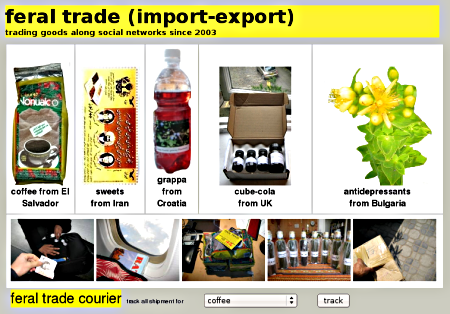
The exhibition includes a retrospective display of Feral Trade goods (2003-present) alongside ingredient transit maps, video, bespoke food packaging and other artefacts from the Feral Trade network. This is art that you can eat, and the café will stock and serve a selection of Feral Trade products from a menu including coffee from El Salvador, hot chocolate from Mexico and sweets from Montenegro, as well as locally sourced bread, vegetables and herbs. Along with their food and drink, diners will be served waybills documenting the socially facilitated transit of goods to their plate. Visitors can also purchase groceries to take home.
Feral Trade has been based in Bristol since 2003 and is well established among media arts practitioners and organisations, who act as couriers, diners and depots in the network. Kate Rich’s Feral Trade Café at Furtherfield.org’s HTTP Gallery extends the model more deeply into the economy of the not-for-profit arts. As well as serving Feral Trade goods, the café will provide a local trading station and depot for the Feral Trade network, and present research and discussion around both food provenance and hospitality protocols for artist-run venues. HTTP Gallery has invited groups from the local Harringay community, as well as local and international artists to contribute their own home-produced food items for sale in the café. Proceeds will support the producers, ongoing development of the project, and HTTP Gallery. Local groups with interest in food, ecology, media and art will also be invited to use the Café as a meeting space.
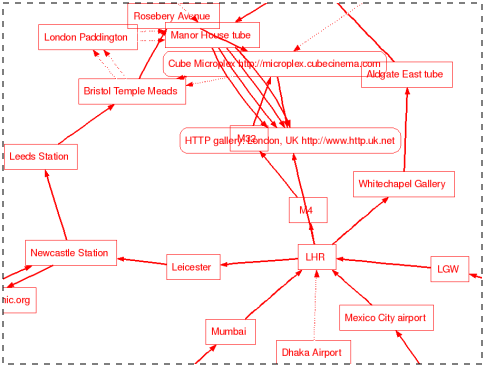
Feral Trade Café is the first element of Furtherfield.org’s three-year Media Art Ecologies programme, which aims to provide opportunities for critical debate, exchange and participation in emerging ecological media art practices, and the theoretical, political and social contexts they engage. The café will be host to events, initiated by Furtherfield.org and others, examining issues related to the Feral Trade and Media Art Ecologies projects, including a Media Art Ecologies networking day. Further info and dates (TBC)
Catalogue Essay: Ecologies of Sustenance by the HTTP Gallery curatorial team
On the occasion of the exhibition, Furtherfield.org and HTTP Gallery are pleased to publish a new essay about the Feral Trade project by writer, artist and designer Femke Snelting of De Guezen (NL)- Feral Labelling
About Kate Rich
Kate Rich is an Australian-born artist & trader. In the 1990s she moved to California to work as radio engineer with the Bureau of Inverse Technology (BIT), an international agency producing an array of critical information products including economic and ecologic indices, event-triggered webcam networks, and animal operated emergency broadcast devices. The Bureau’s work has been exhibited broadly in academic, scientific and museum contexts. Restless at the turn of the century, she headed further east to take up the post of Bar Manager at the Cube Microplex, Bristol UK where she launched Feral Trade. She is currently moving deeper into the infrastructure of cultural economy, developing protocols to define and manage amenities of hospitality, catering, sports and survival in the cultural realm.
More information:
Feral Trade – http://www.feraltrade.org
GastroGeek – http://gastrogeek.wordpress.com/2009/07/29/wasted-again/
Kate Rich – http://bureauit.org/data/krcv/
HTTP Gallery
Unit A2, Arena Design Centre
71 Ashfield Road
London N4 1N4
+44(0)77 3700 2879
Click here for map and location details
Kate Rich will be working as an Artist in Residence at HTTP, Furtherfield’s Gallery and lab space, in Summer 2009. During this residency Kate will develop and work on the first instantiation of the Feral Trade project as working café.
Kate Rich is an Australian-born artist & trader. In the 1990s she moved to California to work as radio engineer with the Bureau of Inverse Technology (BIT), an international agency producing an array of critical information products including economic and ecologic indices, event-triggered webcam networks, and animal operated emergency broadcast devices. The Bureau’s work has been exhibited broadly in academic, scientific and museum contexts. Restless at the turn of the century, she headed further east to take up the post of Bar Manager at the Cube Microplex, Bristol UK where she launched Feral Trade. She is currently moving deeper into the infrastructure of cultural economy, developing protocols to define and manage amenities of hospitality, catering, sports and survival in the cultural realm.
Feral Trade has been based in Bristol since 2003 and is well established among media arts practitioners and organisations, who act as couriers, diners and depots in the network. Kate Rich’s Feral Trade Café at Furtherfield’s HTTP Gallery extends the model more deeply into the economy of the not-for-profit arts. As well as serving Feral Trade goods, the café will provide a local trading station and depot for the Feral Trade network, and present research and discussion around both food provenance and hospitality protocols for artist-run venues. HTTP Gallery will also invite groups from the local Harringay community, as well as local and international artists to contribute their own home-produced food items for sale in the café. Proceeds will support the producers, ongoing development of the project, and HTTP Gallery. Local groups with interest in food, ecology, media and art will also be invited to use the Café as a meeting space.
Feral Trade Café is the first element of Furtherfield’s three-year Media Art Ecologies programme, which aims to provide opportunities for critical debate, exchange and participation in emerging ecological media art practices, and the theoretical, political and social contexts they engage. The project will successively featured at Transmediale Festival, Germany, and the 2010 AV Festival in Tyneside.
Participants: 20 Year 4 students from Southwark Park Primary School.
Artist: Michael Szpakowski (video artist, composer and facilitator)
In a series of workshops to promote enthusiasm for maths within the school, a class of children aged 8-9 years old created Mad About Maths, a CDROM of 8 maths games, which encouraged them to test their ideas, use their own words, and try new approaches. The games were presented in a school event in which the pupils demonstrated the games to their family members and teachers. The pupils were able to share their learning and knowledge of calculation with their siblings and families in an engaging and fun way.
The CDRoms continue to be used in the home and in school with other classes to support enthusiasm and skills in maths.
Partners: Creative Partnerships, A New Direction, Southwark Park Primary School
Ada Lovelace Day was conceived of and promoted by Suw Charman-Anderson as a way of “bringing women in technology to the fore”. It succeded in motivating nearly 2000 people to publish a blog post about a woman in technology whom they admired.
In support of Ada Lovelace Day we invited women working in media arts to join the NetBehaviour.org email list for a week, in March ’09. They were invited to post information about their own work alongside the work of other women who had inspired them in their own practice. Some names came up a number of times but with different stories and for very different reasons. NetBehaviour provided a context for sharing and discussing influences and tracing connections: artistic, practical, theoretical, technical, historical, personal. For readability the list displayed here does not include all of the discussion but this can be traced back through the NetBehaviour archives.
Some contributors were anxious about the many excellent people who may have been missed out. We know this is not a definitive survey or list but it is an excellent resource and just one possible starting point for anyone wanting to know more about women working in media art.
A big THANKS to all of those – women and men – who contributed to this tribute!
—————————————————————————
MY NAME: Ruth Catlow
URL: http://www.furtherfield.org/display_user.php?ID=14
INSPIRED BY
Ele Carpenter
For tech inspired and facilitated participation with Open Source Embroidery, her curatorial project exploring artists practice that explores the relationship between programming for embroidery and computing.
http://www.elecarpenter.org.uk/
Auriea Harvey
For her part with Entropy8Zuper in early intimate networked performances http://entropy8zuper.org/wirefire and for Endless Forest, Tale of Tales’s bucolic social screensaver.
http://tale-of-tales.com/TheEndlessForest
http://tale-of-tales.com/TheEndlessForest
Mary Flanagan
For her energetic explorations as academic, educator, artist and programmer at the intersection of games, art and feminism and exploring collaborative approaches to thinking about values in.
http://www.valuesatplay.org/
Read the full list here
—————————————————————————
MY NAME: netwurker_mez/][mez][[oz.org]/gossama[WoW-Bloodscalp]/bowwtoxx[WoW-Demon Soul]/netwurker_twin[Second Life]/mez breeze [geolocative]
URL: http://mezbreeze.com
INSPIRED BY
Linda Dement
4 her incredible early visual x-periments with trauma + lust + and the visc[f]eral.
www.lindadement.com/
Virginia Barratt
4 her early-90’s inspiration/queer theory + pioneering cyberfeminist work[s] + now 4 her ongoing commitment 2 micro-ecodevelopment.
http://mybigbackyard.blogsome.com
Kathy Acker
4 her pre-emptive writerly mashup-tech[niques] + taking head-on the copyright industry.
http://en.wikipedia.org/wiki/Kathy_Acker
—————————————————————————
MY NAME: Karen Blissett
INSPIRED BY
Sadie Plant
I love her work, especially ‘Zeros + Ones, Digital Women + The New Technoculture’. “Sadie Plant introduces Ada Lovelace as a woman whose awareness of peripheries, of indices, headings, prefaces, etc. gave her a new way of perceiving reality. In her footnoted, non-fictional texts, these peripheral details were crucial in contextualizing the texts in historical and social reality.” Laura Lee. Laura’s review on the book.
http://www.cyberartsweb.org/cpace/body/lgl1.html
Francesca da Rimini
I have always enjoyed Francesca’s net art work as well as her other works/collaborations to do with networked culture. Francesca da Rimini, aka GashGirl, (Adelaide/Rome) has been working in the field of new media since 1984 as an arts manager, curator, corporate geisha girl, cyberfeminist, puppet mistress and ghost. One of the original members of VNS Matrix, the Australian cyberfeminism group formed in 1991. Worked in New York on a project in collaboration with Michael Grimm, snafu and Ricardo Dominguez, los dias y las noches del muertos, and with Ricardo Dominguez on hauntings. Squandered hours investigating the artistic and erotic potential of negotiated email relationships, online virtual communities and web-based narrative architectures that have been reverse engineered into multiple immaterialities.
http://subsol.c3.hu/subsol_2/contributors/dariminibio.html
Ruth Catlow
I know, but she’s cool. And has been incredible in supporting other emerging artists as well as maintaining in still making interesting and challenging artwork with technology. One project springs to mind – ‘Rethinking Wargames’, a participative net art project instigated by Ruth Catlow of which calls for ‘pawns to join forces to defend world peace’. It uses the game of chess to find strategies that challenge existing power structures and their concomitant war machineries.
http://www.low-fi.org.uk/rethinkingwargames/
Hope Kurtz (1959-2004)
Such a talent. I remember seeing Hope perform in Amsterdam in 95 or 96, at the Next Five Minutes Conference – I was mesmerized by her articulation and excellent performance presence, and imaginitive intelligence. Hope “worked behind the scenes of the CAE collective by contributing to the conceptual basis for their work. It is through her brilliant editing that their work articulates challenging concepts to a multifarious audience many of whom might not otherwise come into contact with such radical thought. The Ensemble collectively authored several books including Electronic Civil Disobedience and other unpopular Ideas…”
http://www.thebrooklynrail.org/arts/july04/hopekurtz.html
The Critical Art Ensemble site – http://www.critical-art.net/
—————————————————————————
MY NAME: Tatiana Wells
Free software/media artist and activist from brazil.
URLs:
http://midiatatica.info
http://contratv.net
INSPIRED BY
The collective body of g2g (BR)
http://interfaceg2g.org
Cindy Flores (MX)
http://ciberfeminista.org
The collective body of retome a tecnologia (BR)
http://retomeatecnologia.info brazilian campaign about
violence against women
The collective body of genderchangers (NL)
http://www.genderchangers.org inspiring women all over the world to use free technologies
—————————————————————————
MY NAME: Simon Biggs
Research Professor edinburgh college of art
URL: www.littlepig.org.uk
INSPIRED BY
N Katherine Hayles and Margaret Morse
For their ground breaking work on digital literatures and interactive media.
Vera Molnar
For her pioneering work in developing expressive yet rigorous approaches to computer graphics.
Steina Vasulka, Joan Jonas and Pauline Oliveros
For setting artistic agendas.
Kathy Rae Huffman and Anne Marie Duguet
For their diverse activities, across three decades, to put new media arts and women’s practice, in this area in particular, on the agenda of museums, galleries, journals and the press.
There are many others…
—————————————————————————
MY NAME: Pall Thayer, artist
URL: http://www.this.is/pallit
INSPIRED BY
I second the mention of N. Katherine Hayles and add Christiane Paul.
—————————————————————————
MY NAME: Katharine Norman
I work mostly in digital music/radiophonic sound, and experimental writing about it – interested in listening, people, words, voices, places.
URLs:
Essay with weblinks to sonic work, http://www.stayconscious.com/writings/localmaterials.html
Email fiction, http://www.stayconscious.com/reach/yesreally/
Home page, http://www.novamara.com
INSPIRED BY
a few influences/inspirations from women working with technology and sound
Laurie Anderson
I’ve always regarded her as a sonic anthropologist of the highest calibre.
http://www.laurieanderson.com
Pauline Oliveros
Listener, network performer, thinker, composer, improvising musician. Her way of listening, and her music have been a beacon.
http://paulineoliveros.us/
Magali Babin
Extraordinary French-Canadian performer/composer finding wonderful sounds in unusual and usual places.
http://www.myspace.com/magalibabin
Delia Derbyshire and Daphne Oram
Both for pioneering work in electronic music in the UK, at a time when women were more often in the BBC typing pool than the BBC Radiophonic workshop.
http://www.delia-derbyshire.org/
http://daphneoram.org/
—————————————————————————
MY NAME: Majena Mafe
My work focuses on the perverse affect of sound in/as language, and its
implications for digital ways of saying.
URLs:
http://www.sounded-language.blogspot.com/
http://www.that-unsound.blogspot.com.au
INSPIRED BY
Gertrude Stein
For being a ground breaker, ground shaker and self described genius. For her introduction of the loop in language that eventually filtered through into digital sound that the idea repetition is never repetition. The idea that if objects are things, so too are the word we use for them. That meaning does not lie linearly. She highlighted the non-definitive Her play with ear-play. For her insistent sane use of disruption. Honesty that written language is mock realism. For highlighting the aurally charged nature of language and its connection to meaning.
http://books.google.com.au
Meredith Monk
For sticking with her own throat sounds
http://www.meredithmonk.org/
Cathy Berberian
For interpreting contemporary music, Armenian folk songs, Monteverdi, The Beatles, and her own compositions in a very throated way. Especially for best known work is her “Stripsody” (1966), in which she exploits her vocal technique using comic book sounds.
http://that-unsound.blogspot.com/2008/09/cathy-berberian-trills-me.html
Cathy Brietz
For her elaborate video instillations. For her shots taken at media.
http://www.whitecube.com/artists/breitz/texts/78/
http://www.kunstraum.net/content-en/artists/index/b/candice-breitz/view?set_language=en
Pipilotti Rist
For being ‘not the girl who misses much’. For her insistence on the perverse pleasure principle.
http://en.wikipedia.org/wiki/Pipilotti_Rist
http://www.pipilottirist.net/begin/open.html
Maja Ratkje
For her use of the voice as un-mediated instrumented sound.
http://www.ratkje.com/main.php
Joan la Barbara
For her use of multiple voices. For her use of multiple voices. For her use of multiple voices.
http://www.joanlabarbara.com/bio.html
Vicki Bennett and People Like Us
For the mischief. For her re-examining the throw away sounding out from the 40s and 50s. For the interpolation and density of sound image mashups.
http://www.peoplelikeus.org/index.html
Janet Cardiff
For being a composer/performer intrigued by change, the subtle and the thick in sound, fascinated with voices and definitely enamored by technology. For using her voice as raw material, which she transmutes into machine noises, choral works or pulverizes “into granules of electro acoustic babble and glitch, generating animated dialogues between innate human expressiveness and the overt artifice of digital processing” as the Wire Magazine put it.
http://that-unsound.blogspot.com/2008/08/janet-cardiff.html
—————————————————————————
MY NAME: Annie Abrahams
URLs:
http://www.bram.org
http://aabrahams.wordpress.com
INSPIRED BY
Ada Lovelace
Jane Goodall
Virginia Woolf
Vita Sackville West
George Sand
Donna Haraway
Judith Butler
Olia Lialina
http://art.teleportacia.org/olia.html
and lots of men
yes lots of men
—————————————————————————
MY NAME: Liliana Garcia
My current work is related to Lilith
URL: http://liligrana.wordpress.com/lilithandthetreeliliths-trial-project/
INSPIRED BY
Simon de Beauvoir
For opening my eyes that I have kept alert since then.
Laurie Andersen
For her magnificent acoustic realm.
Kate Bush
Who reminds me of something I cant quiet describe.
—————————————————————————
MY NAME: Alex Olsen (aka Alex Ookpik)
URLs:
www.alexookpik.com
www.myspace.com/alexookpik
www.myspace.com/alexookpik2
INSPIRED BY
Okay, it’s not a short list, but I think that’s a good thing. 😉
*Inspiration from an early electronic music pioneer:*
Laurie Spiegel (added to the list with Daphne Oram et al)
She has recently posted a number of very nice, archival video clips of herself on YouTube. It’s so refreshing hearing her speak in such a no-nonsense way. She’s just so natural about it all (and such a good sport fielding all those awkward questions). Hearing her talk about music and computers so enthusiastically makes me swoon.
www.kalvos.org/spiegel.html
www.youtube.com/watch?v=TzOJtZYsGSA&feature=related
*Mentorship & support:*
To the sound-focused, studio-loving, women that I have met in recent years here in Toronto, who have extended encouragement for my own music & sound studio practice:
Laurel Macdonald
www.improbablemusic.com/laurel/index.html
Anne Bourne (a student of Oliveros)
www.openears.ca/2005_site/2005/westerkamp.htm
Wende Bartley
www.naisa.ca/deepwireless/2002/bartley.html
*Camaraderie & Peers:*
I am so thankful that it seems that I meet more and more women every day who are either pursuing or asking about electronic music, recording, film editing, programming, etc.
I am especially thankful for my friends Eiyn Sof and Building Castles Out of Matchsticks, (did I really have to wait 30 years to find peers?):
www.myspace.com/eiynsof
www.myspace.com/buildingcastlesoutofmatchsticks
*Current Inspiration:*
Juana Molina
For stepping out of a successful acting career into a career making beautiful, unselfconscious, electronically manipulated folk music. To me she has re-defined to archetype of the mad-scientist electronic music ‘guy’, into a steady, feminine, force (especially with her elaborate one-woman live step-up!).
www.myspace.com/juanamolina
*Honorary mentions: *
Brenda Laurel (an early role-model in my interest in human-computer interaction)
http://tauzero.com/Brenda_Laurel/BrendaBio.html
To the supportive men I’ve met along the way, who have treated me as equal,
showed interest in my work and extended opportunities my way.
(I have to put Pauline Oliveros and Laurie Andersen here in brackets as they have been mentioned already but always bear mentioning again! 🙂 )
PS. I too forgot a very important link (in the realm of woman sound artists):
Hildegard Westerkamp
From her site: “Hildegard Westerkamp is a composer, radio artist and sound ecologist. She presents soundscape workshops and lectures internationally, performs and writes.”
http://www.sfu.ca/~westerka/
—————————————————————————
MY NAME: Sarah Cook
URLs:
www.sarahcook.info
www.crumbweb.org
INSPIRED BY
Sara Diamond, Susan Kennard and the many great ladies of the Banff New Media Institute (you all know who you are!)
For organising and producing amazing future-forecasting interdisciplinary rigourously researched events and exhibitions in the field of new media, commissioning artists, building labs and platforms and generally encouraging an atmosphere of knowledge-sharing. I’ve met some of the most important people in my career from my time spent at Banff working for and with Sara and Susan; I owe much to them both, and they know it 😉
www.banffcentre.ca/bnmi
Kathy Rae Huffman
For opening her filofax to me within minutes of our first meeting, at my first visit to Ars Electronica, giving me names and phone numbers and subsequently introducing me to artists and cultural producers. Until that point every curator I had met was quite closed about their research and their social network and Kathy completely obliterated that museum-influenced impression that curating was about gate- keeping. She continues to inspire me by her very honest, ethical and straightforward working method, for not playing the power games so prevalent in the art world, for the early work she did for women in new media in the 1990s, for undertaking one of the first postgraduate courses in curating (actually Exhibition Design and later Museum Studies) and being (and I was also on my MA curating course) one of the few who wanted to work with media artists.
www.faces-l.net/en/user/10
Alison Craighead
For her (collaborative) art work, for being an absolute delight to work with, for helping me question and refine my commitment to new media, to art, to installation, to gallery-museum based practice, to collections, to archives, and to the web. (And together with Jon for teaching me about whisky, how to handle relationship breakups, how to be nice to strangers, how to shop online, how to be a minimalist, how to live and eat well, and where to get the best British change purses and German unctions).
www.thomson-craighead.net
Marina Hyde
For writing so smartly, sardonically, and delightfully about three of my favourite things to read about in the paper/online: politics, sport, and celebrity. On days I wish I were a journalist or blogger rather than a curator (which are many), contributing in an immediate and wide-ranging way to debates which can change minds about popular culture and media, I wish I could be like her.
www.guardian.co.uk/profile/marinahyde
—————————————————————————
MY NAME: Jennifer Radloff
INSPIRED BY
Sally-Jean Shackleton of Women’sNet
For her work in training women in South, and Southern Africa and Africa in digital storytelling. She has also been instrumental in other solid and meaningful activist work that connects activism with the real use of ICTs to transform women’s lives.
www.womensnet.org.za
—————————————————————————
MY NAME: Olga Panades Massanet
URLs:
www.ungravitational.net
http://virtualfirefly.wordpress.com
INSPIRED BY
Francesca da Rimini
For her evocative and cruel mappings of certain realities; her radical use of fiction, of the impossibility coming to life. Her manufacture of peripheral worlds, deeply rooted in actuality, but also exceeding it in a very powerful personal style that floods perception. And particularly for her way of constructing labyrinths that suck you in.
http://subsol.c3.hu/subsol_2/contributors/dariminibio.html
Natalie Jeremijenko
I find particularly inspiring her practical approach and aim to produce actual results. Her current project for example, the Environmental Health Clinic – www.environmentalhealthclinic.net – “develops and prescribes locally optimized and often playful strategies to effect remediation of environmental systems, producing measurable and mediagenic evidence and coordinating diverse projects to effective material change.” “Her work explores opportunities presented by new technologies for non-violent social change. Her research centres on structures of participation in the production of knowledge and information, and the political and social possibilities (and limitations) of information and emerging technologies – mostly through public experiments.”
Coco Fusco
For her ongoing fight against authoritarian policies and repression along borders, inside communities, and across countries. An active feminist working at the intersection of political intervention and media-art. Hers is a critical look into the technologically mediated environments of today that brings about questions in a daring and playful manner.
www.thing.net/~cocofusco
—————————————————————————
MY NAME: Corrado Morgana
Has anybody mentioned Rosalind Franklin?
—————————————————————————
MY NAME: Giselle Beiguelman
Media artist, graduate studies in communication and semiotics – professor, artistic director of Sergio Motta Art and Technology Award
URL: www.desvirtual.com
INSPIRED BY
Jenny Holzer
www.jennyholzer.com
Christiane Paul
too many links…
Ivana Bentes
I could not find anything relevant about her in English. Btw, this is very good (from the WSF),
http://podcast.amarc.org/Social_Forums/WSF/2009/Audios/AudioFiles/Grab_2_Evana_Bantich.mp3
During her speech Ivana argued that the free media movement has to abandon its “cry baby” mentality and make full use of all available technologies. She says that these technologies may have been created within a capitalist paradigm but they should not be held captive to it. We need to use them to advance our communities and peoples.
Virginia Woolf
My favorite writer
Clarice Lispector
My favorite writer too
http://en.wikipedia.org/wiki/Clarice_Lispector
Mez Breeze
mez is mez
www.hotkey.net.au/~netwurker
Laurie anderson
www.laurieanderson.com
—————————————————————————
MY NAME: Pall Thayer
INSPIRED BY
Oh, and let’s not forget the tireless work of Jo-Anne Green and Helen
Thorington at Turbulence.org
—————————————————————————
MY NAME: Perry Bard
www.perrybard.net
http://dziga.perrybard.net
INSPIRED BY
Berta Sichel
Director of Audiovisuals at the Reina Sofia Museum Madrid who recently started a video collection for the museum. The inaugural exhibition for the the collection contained 32 installations, 12 of them by women (maybe a museum record?) and her programming has celebrated a wide range of internationally known women.
Second Sarah’s eloquent praise of Kathy Rae Huffman who was Director of Cornerhouse which commissioned my artwork Man With A Movie Camera: The Global Remake through its Bigger Picture program. Every artist should be as lucky as I was to have such an encouraging and supportive working relationship.
Simone De Beauvoir
For contributing a female voice to the history of western thought.
—————————————————————————
MY NAME: Ghislaine Boddington
working within the group body>data>space
www.bodydataspace.net
with ResCen Middlesex University
www.rescen.net/Ghislaine_Boddington/index.html
and previously early digital sound and movement collective shinkansen
see here for shinkansen and Future Physical archive
www.connectivity.org.uk
INSPIRED BY
many many women across the years and we believe by even more of the future generations to come !!! in particular for us, the following women have been imperative as mentors in our development of interauthored telematic performance
Thecla Schiphorst
For her work on embodiment, sense enhancement and the human side of digital interaction. She worked as part of the original development team of Lifeforms software, the computer compositional tool for choreography and she has worked with Merce Cunningham since 1990 supporting his creation of new dance with the computer. She inspires many with her work at Simon Fraser University Vancover and with her international exhibits including Bodymaps: artifacts of Touch, an pioneer touch based video body installation. We have been pushed by her thinking and questioning while working with her producing the second iteration of “whispers” for Future Physical (Cambridge 2003) and producing Bodymaps into the ICA as part of Virtual Incarnations Dance Umbrella 2000.
www.sfu.ca/~tschipho//
Hellen Sky
Digital choreographer and telematic dancer, writer and director, the most experienced dancing woman in cyberspace !!! Hellen is the prophet we all need to look to for her early work on telematics and technology within the performance and installation space, using realtime data generated by the body. Co-founder of Company in Space in Melbourne (1992 – 2004) this group, who we worked with several times into the ICA and other contexts, was an inspiration for all dance technology in the 90s. We worked Hellen again recently for the Post Me-New ID Forum in Dresden and here is an excerpt of her writing from Virtual Physical Bodies catalogue, published by centre des arts d’Enghien-les-Bains, Paris, for the body>data>space exhibition Oct 2008 – Jan 2009
www.hellensky.com/hellen.swf
“….Although there is no gravity here
The weight of time holds me to this virtual floor
As you wait for me to arrive in streamings of bits and bytes,
zeros and ones
In realtime, lag time, day for nighttime
To arrive at the unstable matrix of my new skin
The screen is not a surface but reach of my extended touch “
….Hellen Sky
Amanda Steggell
For early work as online band Nood, releasing the first internet CD in early 1996. Inspirational work with Per Platou as Motherboard with installations and performative live art happenings, mediated and modulated by the intermediary influence of the net, often integrate audience participation and interaction. For ongoing exciting emotive projects, bringing sensitivities and real human presence to “dry” net time projects.
www.liveart.org
www.liveart.org/motherboard/index.html
Plus here, in London +++, so many great women working tirelessly, across all disciplines and the digital, often not getting much credit over the years………………
Rachel Baker
Leanne Bird
Ilze Black
Larisa Blazic
Susan Broadhurst
Ruth Catlow
Anna Collin
Susan Collins
Kelli Dipple
Bronac Ferran
Julie Freeman
Ruth Gibson
Lizbeth Goodman
Karen Guthrie
Vesna Grandes
Delphine Gaborit
Lisa Haskell
Dianne Harris
Leslie Hill
Laura Henry
Mia Jankowicz
Janis Jefferies
Shobana Jeyasingh
Francoise Lamy
Sophia Lycouris
Pauline van Mourik Broekman
Helen Paris
Sarah Platt
Nina Pope
Hannah Redler
Gini Simpson
Annika Stark
Nicola Triscott
Claire Welsby
Sheron Wray
Marie X
who have we forgotten ? sorry……..please do add more ……………:-)
PS this list proves there is no shortage of women in UK for panels and keynotes …….so how come so many conferences, panels, etc still have so very few women involved …..?????
—————————————————————————
MY NAME: Renee Turner
Collaborates with Riek Sijbring and Femke Snelting under the name of De Geuzen a foundation for multi-visual research
URLs:
www.fudgethefacts.com
www.geuzen.org
www.geuzen.org/female_icons
INSPIRED OR IMPRESSED BY (AND THESE ARE JUST A FEW):
Donna Haraway
Author of A Cyborg Manifesto: Science, Technology, and Socialist-Feminism in the Late Twentieth Century, she has a way of embedding and embodying technologies within history, science, bodies and everyday life.
Online lecture here: www.youtube.com/watch?v=-yxHIKmMI70
A Cyborg Manifesto: www.stanford.edu/dept/HPS/Haraway/CyborgManifesto.html
Laurie Anderson
Jack of all trades, hacker, pioneer and techno-shaman. In 1984, I saw her United States Live tour, and was humbled to witness it.
www.youtube.com/watch?v=SirOxIeuNDE
Steina Vasulka
An early pioneer of the electronic arts, Steina, often in collaboration with her partner Woody Vasulka, pushed the aesthetics of technology and video to its outer limits. In 1974, she taught at the Center for Media Study at the State University of New York, where she was the only female faculty member at that time. Through the years her work has played with the limits of technology while simultaneously embracing those restraints for their visual qualities. One particular example of this kind of approach is Machine Vision. An interview can be found here:
www.youtube.com/watch?v=yd9jaqkY6Dw
Joan Jonas
She is a funky storyteller who has the capacity to weave together the rinky dink, the poetic and the technological. A snippet of Vertical Roll is here: www.medienkunstnetz.de/works/vertical-roll/video/1/
Charlotte Moorman
Bold, experimental and a fantastically lateral Southern thinker. Worked with Nam June Paik and had zero fears about toying with new technology. She also had a tremendous sense of humor.
Interviewed here: www.youtube.com/watch?v=wiEJdOlgcDE
Avital Ronell
The author of The Telephone Book: Technology, Schizophrenia, Electric Speech, is a mental broad surfer par excellence. Not only has she theorized about technology, but also stupidity, addiction and literature. She has a way of making wildly rogue connections. There is no link of her discussing The Telephone Book, but here’s one where she discusses stupidity:
www.youtube.com/watch?v=u3ksoUF0jjY
Lisa Haskell
Organized different projects around technology and digital culture. I haven’t seen her in years, but those early projects were inspiring and brought many people together to think and produce in different ways.
Christina McPhee
Artist and writer….works with data landscapes. I have admired her as a moderator on Empyre for years. She has a way of raising the calibre of discussion without being exclusive or intimidating. That is truly a rare trait on list culture.
Pauline van Mourik Broekman
She co-founded with Simon Worthington Mute Magazine.
Kate Rich
The Bureau of Inverse Technology: Many years ago De Geuzen, asked her to come to the Netherlands and lecture at a symposium called Situating Technologies. She gave an inspiring talk on the Bureau’s activities. The suicide box is still brilliant.
www.bureauit.org/sbox/#video
Sandy Stone
She is Associate Professor and Founding Director of the Advanced Communication Technologies Laboratory. I admire her ability to forge new ways of thinking about gender, machines, the erotic, science and frontier bodies. I saw her perform several years ago at V2 in Rotterdam, and she is an amazing storyteller. Last but not least, she has a great sense of humor.
www.youtube.com/watch?v=KLkqFy6J14w&feature=related
Josephine Bosma
Through her essays and interviews, she’s made valuable contributions to media art history and debate.
Annie Abrahams
Dutch artist residing in France who studied both biology and fine art. Her work explores the impact of technologies in critical, poetic and quirky ways. It also points to the many inherent contradictions of mediated connectivity. Next to her work, she has created numerous nodes of exchange and production within the net art community.
Riek Sijbring and Femke Snelting (aka De Geuzen)
I have worked with both of these women for almost 15 years. Through practicing together, we have learned much about feminisms and media ecologies.
I could keep going and going with more women…. but I better stop here for the moment 🙂
—————————————————————————
MY NAME: James Morris
INSPIRED BY
Mez
She has been an influence in some of my writings/list posts, and I love her graphics work (I’d love her to design an alternative set of icons for my game;-).
Delia Derbyshire
Discovering about her and her early work with synthesis for the Doctor Who theme was exciting and inspiring. Two books I found very interesting to read were “The Demon Lover – the roots of terrorism” by Robin Morgan, and “Bosch” by Laurinda Dixon.
—————————————————————————
MY NAME: Rhea Myers
INSPIRED BY
Ada Lovelace
The original hacker.
Jasia Reichardt
For Cybernetic Serendipity, “The Computer in Art”, and after.
Tessa Elliot
Interactive multimedia artist and influential teacher.
Tracey Matthieson
Online multi-user VR pioneer.
Susan Kare
Designed the influential original Macintosh icons.
—————————————————————————
MY NAME: Alan Sondheim
INSPIRED BY
Katherine Hayles
She has written on digital writing and literature – more importantly, I think, she’s written absollutely brilliantly on the philosophy of first and second-order cybernetics.
Wendy Chun
She has written on protocols, issues of control, and co-edited a brilliant new media reader.
Margaret Boden and Sherry Turkle
Both made, I think, the most critical contributions understanding of online psychology and phenomenology. Everyone should read their work.
Brenda Laurel
A brilliant writer whose work on theater and interface is really critical to understanding online interaction.
Julia Kristeva
Her theories of the chora and abjection resonate in cyberspace – I’m thinking of Powers of Horror for example.
Luce Irigaray
Her notion of fluid mechanics and its relation to the feminine is more than descriptive of online phenomenology – see Speculum of the Other Woman.
Anna Munster
Her book Materializing New Media: Embodiment in Information Aesthetics, has been a touchstone for me.
Ann Weinstone
Check out Avatar Bodies, A Tantra for Posthumanism – one of the very few sources really connecting Buddhist thought with cyber-space.
Mez
I know other people have mentioned her – but she has brought code and body together in cyberspace in a totally new way.
Sugar Seville
She ran the Odyssey Artspace sim in Second Life for years and created one of the most dynamic online cultural experiments and experiences I’ve seen
Stacy Horn and Theresa Senft
Check out,
www.terrisenft.net/writing/grandinterview.html
Stacy Horn
She’s a pioneer in social networking – check her out!
www.echonyc.com/~horn/bio.html
—————————————————————————
MY NAME: Patrick Simons
INSPIRED BY
Delia Derbyshire
www.delia-derbyshire.org
Yoko Ono
www.a-i-u.net/biblio3.html
Annie Anxiety
www.youtube.com/watch?v=nFdoPhytGqU
Maja Ratkje
www.last.fm/music/Maja+Ratkje
Katherine Norman
The impressively pioneering, used to use as The example of new work in lectures, her ‘My London CD’. Most of the tracks are up on sonus.ca and/or last.fm
www.last.fm/music/Katharine+Norman
—————————————————————————
MY NAME: Rachel Beth Egenhoefer
URL: www.rachelbeth.net
5 WOMEN I THINK ARE AMAZING:
Katherine Hayles
I know she’s been mentioned already… “How we became Post Human” is one of my favorite books. In addition to being incredibly smart, ahead of the curve, able to make an argument and stand by it, I can say from personal experience that she is one of the most lovely academics to meet in person. I had the honor of working with her when she was at UCLA and I was always amazed at how down to earth and easy going she was. Able to sip a soda, make jokes, and talk about the news, and then go right into intense theory about the printing press and reading novels on mobile phones. FYI, she is now at Duke University.
URL: http://fds.duke.edu/db/aas/Literature/n.hayles
Martha Rosler
In one of my very first video classes back in undergrad we watched “Semiotics of the Kitchen” and I was hooked. Today some of my students find this video boring (not enough whiz bang for them I guess) and it frustrated me that they can’t put themselves in the time period that it was made and see it as an exploration of trying to figure out what the medium was and what it could do. In addition to her early videos she has written and edited numerous essays and books. She is still making work in New York and teaching at Rutgers University.
Sandy Stone (aka Allucquere Rosanne Stone)
Along with Sadie Plant who has already been mentioned, her texts are some of my favorites. “Split Subjects, Not Atoms; or, How I Fell in Love with My Prosthesis” is an oldie but a goodie and I think way ahead of it’s time. I think she brings an interesting addition to the list as a transgendered individual. Her semi-new website it pretty amusing…
http://sandystone.com
Margaret Morse
“Video Installation Art: The Body, the Image, and the Space-in-between” is a wonderful little easy she wrote that is in a book “illuminating Video”. I ready this years ago and still come back to it. I think that “video” should be dropped from the title as it really speaks to a lot of different kinds of art forms and how we view them, create them, display them, etc. She of course has many other texts as well, all written very intelligently but accessible.
Sue Gollifer
This email wouldn’t fit in your inbox if I listed everything Sue has a hand in. To name a few she is either on the board/ a member of/ holds a position in ISEA, SIGGRAPH, CAA (College Arts Association), Computer Arts Society (CAS), DACS (Design and Artist Copyright Society), Lighthouse Brighton, and many many more, all while also heading the MA in Digital Arts at the University of Brighton, working with Digital Printmaking, writing, making, and yes she has pink hair. Sue is no-nonsense, tells it like it is, gets things done, is amazingly successful, and yet still has a ton of fun, and is incredibly kind and generous.
http://artsresearch.brighton.ac.uk/research/academic/gollifer
And lastly as one extra… I’d like to add Ada’s mother – Anna Isabella Noel Byron. She is the one who raised Ada and encouraged her to study math and science instead of literature.
http://en.wikipedia.org/wiki/Anne_Isabella_Milbanke
—————————————————————————
MY NAME: Aileen Derieg
I work as a translator with an emphasis on Contemporary Art and New Media.
URL: http://eliot.at
INSPIRED BY
Judith Butler
Again and again, reading Judith Butler’s books has helped me to feel not quite so powerless in a world that I do not agree with. The way she questions things that seem to be taken for granted, proposing radically different ways of understanding the world that make so much more sense – her books are certainly among the most important I have read in my life.
http://rhetoric.berkeley.edu/faculty_bios/judith_butler.html
Faith Wilding
A description I read many years ago as a young student of Faith Wilding’s “Invitation to a Burning” was what first captured my attention and awakened my interest in Faith and her work. Years later I was even more impressed to realize how she had continued to develop and evolve her work and ideas. When I first joined the Faces mailing list in the late 90s, I nearly fell off my chair when the first response to my introduction was a personal welcome from Faith. Having admired and looked up to this woman for so long, I was deeply touched by her response.
A few years ago, in the midst of a conflict, when I was feeling sad and low, I was standing at a window looking down on an empty space, which made me think of “Invitation to a Burning” again. I wrote to Faith then and told her how sad I felt, how I missed the kind of exhilarating actions that have meanwhile become part of art history. I was very grateful for and encouraged by her response. To me, she is not only a fascinating and inspiring artist and an intelligent and thoughtful writer, but also a wise woman.
www.andrew.cmu.edu/user/fwild/faithwilding
Margarete Jahrmann
I first became aware of Margarete through the “Poptarts” section of Telepolis that she and Kathy Rae Huffman were responsible for, so I think in many ways Margarete was really the one who first introduced me to the possibilities of feminist digital art. What I especially love about her work is the way all the many layers are ultimately transparent. Even though some of her writing may appear confusing at first glance, there is a depth and fundamental coherence to it that I find fascinating. As engaging as her work is at a first look, as often as I come back to it and look again, I invariably find there is always even more to it.
www.konsum.net
www.ludic-society.net
Amy Alexander
Like Margarete, Amy is someone I admired first, long before I had the pleasure of becoming personally acquainted with her. The first time I heard of Amy’s work was when she received an Honorary Mention in the Prix Ars Electronica for the “Multicultural Recycler”. When we later met through the Faces mailing list, I thoroughly enjoyed her sense of humor and her delightfully geeky interests. As we have stayed in contact since then, this is what I continue to especially appreciate and enjoy. What I love about Amy’s work is the way the humor, the not-so-serious view of things, is rooted in a very serious and well founded understanding of the issues at stake. She has an amazing ability to grasp complex issues and condense them into concise and witty statements.
http://amy-alexander.com
Paula Graham
Some years ago there was an interesting thread on the Linuxchix “issues” mailing list about how the women subscribed to the list became involved in computing. All the stories were wonderful to read, but the one that completely blew me away was Paula Graham’s. Not very long after that, I had the great pleasure of meeting Paula at the Eclectic Tech Carnival in Graz, and she has been very high on my personal list of most admired women ever since.
I’m not sure whether Paula actually invented the term “accidental techie”, but she is certainly the person I learned it from, meaning that when any kind of group reaches the point where they need to use technology, *somebody* has to figure out how to do it. Paula is most insistent about convincing other women to be self-confident and self-reliant enough – no matter what their background – to become that *somebody*. One of the most important lessons I have learned from Paula is that women don’t always need to be “nice”, and that can be quite a liberating insight.
www.opengender.org.uk
http://bastubis.wordpress.com
—————————————————————————
MY NAME: Ximena Alarcon
URLs:
http://www.deeplistening.org/site/artists/a
http://www.ioct.dmu.ac.uk/projects/ISE.html
I compose virtual sound environments and transform my scores in multimedia interfaces. I am extending and re-implementing an Interactive Sonic Environment – London Underground, which I initially built in Director, using Lingo language.
http://bartleby.ioct.dmu.ac.uk/~xalarcon/project/interactive.html
Soon, I will launch my site that links the metros of London, Paris and Mexico, thus you can have a virtual journey through the sounds of these three acoustic environments, on Internet. As a branch of this work, I have worked a networked off-line improvisation called “Listening and Remembering”, for commuters and their voice (in Mexico and Paris), in collaboration with Peter Batchelor.
Technology for me is not a goal, but a set of powerful cultural tools to analyse, experiment with, and extend perceptions of the world. My recent artistic work is mainly based on ethnographic work with commuters: http://soundingunderground.wordpress.com
INSPIRED BY
I am inspired and feel encouraged with these women’s work in art and technology:
Pauline Oliveros
Her outstanding work in electronic music and the continuous innovation in the use of technologies extending her philosophy of deep listening.
www.deeplistening.org/site/artists/O
IONE
Her art, dynamic networking, stimulating women’s art and power through dream work, using telecircles.
http://ionedreams.us
Serena Alexander
Strong electroacoustic textures and gestures, clean and master work, extending the power of her voice.
http://serenaalexander.com/
Jess Laccetti
A master blogger!
http://www.jesslaccetti.co.uk
Noemi Peña
Researcher in high technology to create “Custom Ceramic Products”
www.linkedin.com/pub/8/9b8/a48
—————————————————————————
MY NAME: Diana McCarty (of Faces)
INSPIRED BY
Prof. Dr. Heidi Schelhowe
For her amazing work combining feminist concepts in technological models and her work with illustrating how important the construction of knowledge is: She informs just about everything that I do!
http://dimeb.informatik.uni-bremen.de/content/view/307/138/
Seda Guerses
Her work as a computer scientist is incredible. She asks the right questions and is a constant challenge to some very dangerous assumptions about privacy.
www.cs.kuleuven.be/~seda
Uschi Reiter
For her tireless commitment to working for Women in Technology. She is able to realize elegant participatory models.
www.firstfloor.org/ur/blog
Michelle Teran
Her work is incredible – she connects the social with so many aspects of technology.
http://techformance.blogspot.com/
VNS Matrix
They just got it: their early understanding of what was possible and scary about big daddy mainframe and how to subvert it!
http://lx.sysx.org/vnsmatrix.html
Gender Changers
Because they rock!
www.genderchangers.org
The Eclectic Tech Carnival
Because they rock!
www.eclectictechcarnival.org
Faces Community
Possibly the only 90’s mailing list that can sort out a cup of coffee, a sofa to sleep on and has members that organize their own meetings whenever they get the chance.
www.faces-l.net
—————————————————————————
MY NAME: Francesca Da Rimini
INSPIRED BY
Linda Dement
A huge inspiration for me since i first met her in adelaide’s small but wild queer punk scene back in the early 1980s. her work is beautiful, fearless, adept.
www.lindadement.com/index.htm
Shu Lea Cheang
We met on email, i think through linda dement. creates complex multi-layered spaces mixing on and offline exploring issues around sex, violence, prejudice, society. pushes boundaries, always with incredible style, seductive surfaces, humour. a mistress of the interface.
Silvia Federici
Extraordinary radical historian. her book Caliban and the Witch examines women, labour, power and dispossession through the lense of inquisitions, demonisation and other forms of violence. a compelling account which can be read many times.
www.generation-online.org/p/pfederici.htm
Teri Hoskin
Philosopher, artist, criss-crossing media as the ideas demand. not afraid of the dark, ever. someone i can send my writing to, at any stage of roughness, without shame.
www.altx.com/ulmer/hoskin/fishtrap.html#
Rea
Artist working in sculpture, photography, digital media, installation. explores issues around indigenous/colonial histories and representation. smart, powerful, straight up.
www.artreview.com.au/art/profiles/artists/mint–r-e-a.aspx
—————————————————————————
MY NAME: Ele Carpenter
The Open Source Embroidery project has led me to some fantastic women working with media arts and crafts in many different ways. So I’d like to nominate a list of women artists and writer who have inspired me in their rigorous enquiry, and whose work will, or should, go in the history books.
I’ve also blogged about Ada Lovelace on www.eleweekend.blogspot.com to highlight Richard Hamilton’s poster Free Ada Lovelace, which can be seen to make the connection between access to culture, museums, computing and software.
INSPIRED BY
Joanna Drucker
www.gseis.ucla.edu/faculty/members/drucker
Sneha Solanki
http://electronicartist.net/solanki
Aileen Derieg
http://eipcp.net/transversal/0707/derieg/en
Kate Pemberton
www.artisopensource.net/index.php
Becky Stern
http://sternlab.org/
—————————————————————————
MY NAME: Tracey Meziane Benson
URLs:
www.byte-time.net
www.fauxonomy.org
www.dorkbot.org/dorkbotcbr
INSPIRED BY
Linda Carroli – Writer, artist and commentator.
http://flytrapper.synthasite.com
http://artwriting.blogspot.com
http://transmissionlines.blogspot.com
http://twitter.com/lcarroli
Patrica Piccinini – artist
www.patriciapiccinini.net
Linda Dement – artist
www.lindadement.com
Elizabeth Grosz – academic
http://en.wikipedia.org/wiki/Elizabeth_Grosz
—————————————————————————
MY NAME: Anne Roth
I wouldn’t consider myself being active in media or net arts, rather activism. I did an Ada Lovelace blog post (in German)
http://annalist.noblogs.org/post/2009/03/25/ada-lovelace-day-star-simpson-and-donna-metzlar about:
Donna Metzlar
Activist and (one of the) driving force(s) with the Genderchangers, www.genderchangers.org and Eclectic Tech Carnival, http://eclectictechcarnival.org
Star Simpson
Who was arrested at the Boston Airport (and later convicted) for “wearing a hoax device”, a selfmade LED application (see http://boingboing.net/2007/09/21/mit-student-arrested.html). She described herself in one sentence as “I’m an inventor, artist, engineer, and student, I love to learn, build, and do” and here are some of the things she built.
http://starbur.st/portfolio
—————————————————————————
MY NAME: Max d. Well
INSPIRED BY
Lynn Hershman Leeson
Already kinda literally associated by one of her outstanding works: the movie *Conceiving Ada*… all her works (installations, videos) make her one of the most influential and important woman artists of the last decades
—————————————————————————
MY NAME: Micha Cardenas
I was so excited to see this, as I’m always filling in my students about ada lovelace, who seems to get left out somehow of our “introduction to computing and the arts” class, often, or only brielfy mentioned…
So I signed up for the list. But I’m not a woman, I’m transgender. I don’t identify as a man or a woman, but I guess you could say I’m mtf, in permanent transition. So, if you want a submission from a femme transgirl, here goes…
I’m interested in the interplay of the body, technology and biopolitics. I did a performance called Becoming Dragon in dec 2008. just finishing up my MFA at ucsd, just started working in sheldon brown’s experimental game lab.
URLs:
http://technotrannyslut.com
http://secondloop.wordpress.com
INSPIRED BY
Avital Ronell
Philosopher of technology, for being my friend and mentor, ever so briefly, one summer at EGS, and a massive inspiration who turned my whole idea of knowledge and thought and ways of approaching politics upside down and inside out. i can’t even describe how much i owe to her…
http://as.nyu.edu/object/avitalronell.html
Allucquere Rosanne (Sandy) Stone
Another philosopher of technology, another amazing woman who i met at EGS who was so supportive of me throughout my 15 immersive performance of Becoming Dragon, being more than generous, providing guidance, wisdom and grounding, and for thinking through the questions of online worlds and gender so long before i even started considering them, and for so generously providing me with personal advice about transitioning that was so valuable to me.
http://sandystone.com
Adriene Jenik
Networked performance artist, creator of distributed social cinema – adriene is one of the main reasons i am even in grad school and decided to dedicate myself to being an artist and has also been so, so generous and giving throughout my years working with and knowing her. her warmth along with her deep, deep knowledge of new media art has guided me so much. she has been one of the main people in my life to really educate me about feminism.
http://adrienejenik.net
Orlan
For not being afraid to find the limits of merging the body and technology, orlan is the artist who has inspired me most. i think her work is a shining example and challenge to artists’ commitment everywhere.
http://orlan.net/
Donna Haraway
Another massive inspiration for how i think about politics and technology and the body who’s thinking on interspecies and transspecies relationships helped me develop my own ideas in my work.
Beatriz da Costa
Bioartist, interspcies collaborator. For making so much inspiring bioart, for the brilliant, brilliant term Tactical Biopolitics, for her guidance in one short studio visit about Becoming Dragon which helped me reframe my approach to the whole project, and which has turned out to me a great suggestion.
www.beatrizdacosta.net/
Elle Mehrmand
My closest and dearest friend right now, a brilliant new media performance artist and beautiful, strong, brave ally.
http://visarts.ucsd.edu/something-happening/?author=18
http://myspace.com/assemblyofmazes (that’s her band, but she’s working on a website soon)
Subrosa
For their brilliant linking of witch hunts, queer and gender variant persecution and feminine knowledge production in Yes Species.
http://cyberfeminism.net
probably not surprising, but its my personal list…
—————————————————————————
MY NAME: Marc Garrett
URL: www.furtherfield.org
INSPIRED BY
Anne-Marie Schleiner
Velvet-Strike. www.opensorcery.net/velvet-strike – A collection of spray paints to use as graffiti on the walls, ceiling, and floor of the popular network shooter terrorism game “Counter-Strike”, conceptualized during the beginning of Bush’s “War on Terrorism.”
“…part of a growing movement to bring a message of peace, love and happiness to online shooters by any means necessary. Graphical User Intervention, a more radical group of protesters, will go so far as to sacrifice their characters for the greater cause of getting out a message of non-violence.” Wired.
When this appeared on the net art scene in 2002 I completely understood and appreciate why Anne-marie used her computing and art skills to embark in such a dynamic interventionist tactic, in challenging the psychology, attitudes and fetish around violence and war in the form of interventionist, networked play. It had to be done, especially in contrast to the overwhelming experience of witnessing our governments and media falling into the typical trappings of opting for more violence to (supposedly) solve terrorism. I personally, found it all extremely frustrating seeing the world torn apart by other (slack) males, as well as those who bought into. This is also one of the various anti-war net artworks, which inspired me to make some of my own anti-war net art-works.
Aileen Deirig
Aileen, for her dedication in being part of and supporting various contemporary, independent groups and organisations; many involving women where she has selflessly shared her energy, ideas and varied skills, whether it be in programming, writing or social engagement. A collaborator who genuinely incorporates her personal, social and contextual beliefs into her everyday life and practice. I also admire her intelligence in understanding that art is not just about product, but also fluid place where contemporary factors such as feminism, politics, technology and human context all have a place, allow agency. Some of the projects that Aileen has been involved with are:
Genderchangers – http://genderchangers.org,
The faces list – www.faces-l.net/,
the Servus blog – http://core.servus.at/node/164,
the Furtherfield blog – http://blog.furtherfield.org (thanks Aileen),
Monochrome Blog – http://www.monochrom.at/english,
and more.
You find more Aileens projects, translations and writings here – http://eliot.at
Josephine Bosma
Josephine is also important to mention, especially in repsect of her work around net art, networked cultures and media art generally. From 1991 until 1998 Josephine Bosma worked with the independent station Radio Patapoe in Amsterdam and also with VPRO radio, a Dutch national broadcaster. Since 1993 her focus has been on media art and media theory and she has published numerous interviews and essays in book collections and in magazines including Mute (UK), Telepolis (D), UHK (NO), and Switch (USA). She played a key part in organizing the radio part of the Next 5 Minutes 2 and Next 5 Minutes 3 festivals, and has edited the streaming media sections of the nettime book, ReadMe and the N5M3 workbook. In January 2001 Josephine initiated the newsletter for net art criticism, Cream. Josephine Bosma lives and works in Amsterdam. Josephine Bosma’s Database, here you will find essays, articles, lecture notes, transcripts and broadcasts etc.
http://laudanum.net/cgi-bin/media.cgi?action=frontpage
Sadie Plant
The most important Sadie Plant book for me was ‘The Most Radical Gesture: The Situationist International in a Postmodern Age, published in 1992. It’s one of those books that you read over and over again. What I personally got from it was how rich her perspective was in contrast to most Situationist historical texts on the subject, and more expansive. Here is a link to an interesting interview with Sadie Plant Brett by Stalbaum and Geri Wittig – http://switch.sjsu.edu/web/v5n1/plant/
If you have not read The Most Radical Gesture and do not wish to take the risk of buying it, why not visit here on Questia where you can read it on-line and copy etc www.questia.com/PM.qst?a=o&d=103446663
—————————————————————————
MY NAME: Helen Varley Jamieson
my ada lovelace day post:
http://creative-catalyst.com/serendipity/index.php?/archives/13-AdaLovelace-Day.html
—————————————————————————
MY NAME: Michelle Kasprzak – Curator & Writer
…and here’s my post, too!
http://michelle.kasprzak.ca/blog/archives/365
—————————————————————————
blogged at: http://m3me.wordpress.com
Ada is an inspiration as much in her foresight as in the ways she accomplished and implemented her ideas. going beyond the conventions of her days, she did not let herself being encloistered by her class and society, but found ways to implant her ideas into the public sphere.
Conceiving ada was my initiation to her life and work, transposed already to our times.
Technology stems from the industrial-military complex, and what it is missing most, in order to be used artistically, is poetry. poetry as in beauty, as in emotion, as in awe.
Here some contemporary artists i came across that are driven in this way:
natabor: www.aa-vv.org
adriana sa: http://adrianasa.planetaclix.pt
ursula scherrer: www.ursulascherrer.com
sculptrice: http://iiie.klingt.org/sculptrice
This brings us back to nature, maybe the most compelling discussion we should be having, as an arrogant, snobish past is giving way to a growing sensation of symbiosis and the fragility of its interrelations.
A 130 year old woman was ‘discovered’ in kazakhstan; when asked (how? why? – kind of silly really; as if they were not more interesting points of debate) attribute humor and using grandmother’s cures for all ills. An unbroken chain of knowledge, that women can pride themselves on. Interestingly, it is not always adquired but can ‘feel’ intuitively right.
Ada is as close as it can get to adam, ‘the first one’, tricked out of paradise and innocence by the scheming eve, eager for more; our chastity belt ever since. this might be coming full circle..
There is a growing movement of women empowerment worldwide, which will make a difference, specially when the patriarchal society is about to wave the white flag; like the microcredit movement or video volunteers:
http://www.videovolunteers.org/
Ada is not about any specific thing, she is about the ‘going beyond’ oneself to achieve something that wants to come forward. it is about doing the intuitive thing. names don’t really matter. it is about communication and exchange. she developed a part of that, the growing ‘global consciousness’ we call ‘the net’ – a tool that shrank space and time;
curious where it will take us..
—————————————————————————
MY NAME: Nina Gazire
URL: http://blog.premiosergiomotta.org.br/
INSPIRED BY
Hanne Darboven
Since the 1960s, Hanne Darboven has focused her art-making on daily “writings” that chronicle existence and evoke the passage of time. The 2,782 typed and hand-written daily writings or drawings that make up Leben, leben/Life, living represent Darboven’s systematic approach to counting the years 1900 to 1999. These drawings make visible two orders of time: the actual time taken to create them and the historical time that they summarize. Darboven asserts the presentness of time by marking its passage in a literal form that also takes up volumetric space when the writings are installed in a large gallery. The work also includes two dollhouses that are part of Darboven?s extensive collection of popular artifacts. The houses, photos of which are included in the installation, also mark time as one represents a nineteenth-century German home and the other a house from the 1950s.
http://www.cmoa.org/international/html/art/darboven.htm
Donna Haraway
Donna J. Haraway (born September 6, 1944 in Denver, Colorado) is currently a professor and chair of the History of Consciousness Program at the University of California, Santa Cruz, United States. She is the author of Crystals, Fabrics, and Fields: Metaphors of Organicism in Twentieth-Century Developmental Biology (1976), Primate Visions: Gender, Race, and Nature in the World of Modern Science (1989), Simians, Cyborgs, and Women: The Reinvention of Nature (1991), Modest Witness@Second Millenium. FemaleMan Meets OncoMouse: Feminism and Technoscience (1997, Ludwig Fleck Prize), The Companion Species Manifesto: Dogs, People, and Significant Otherness (2003), and When Species Meet (2008). Haraway earned a degree in zoology and philosophy at the Colorado College and received the Boettcher Foundation scholarship. She lived in Paris for a year, studying philosophies of evolution on a Fulbright scholarship before completing her Ph. D. from the Biology Department of Yale in 1972. She wrote her dissertation on the functions of metaphor in shaping research in developmental biology in the twentieth century.
Gilda de Mello e Souza
Gilda de Mello and Souza (Sao Paulo, Brazil, 1919-2005) was a philosopher, critical literary, writer and Brazilian university teacher. She passed her infancy in the farm of the parents, in Araraquara,Sao Paulo’s country, but returns the Sao Paulo in 1930 to study. She entered the College of Philosophy, Sciences and Literature of the University of Sao Paulo in 1937, graduating in Philosophy in 1940. She collaborated in the production of the magazine Clima, together with its future husband Antonio Candido. In 1952 she receives completes her PhD in Doctor in Social Sciences with the defense of the intitled work The fashion in century XIX, publishing the thesis in 1952. In 1954 she became assumes the chair of Aesthetic in the Department of Philosophy of the USP, department that would be directed by Gilda between the years of 1969 and 1972. She retires in 1973 and becomes: Teacher of the College of Philosophy, Literature and Human Sciences of the USP
in 1999.
Martha Rosler
Martha Rosler (born July 29, 1943) is an artist. She was born in Brooklyn, New York, where she now lives. She graduated from Brooklyn College (1965) and the University of California, San Diego (1974). Rosler works in video, photo-text, installation, and performance, as well as writing about art and culture. Her work and writing have been widely influential. She has lectured extensively nationally and internationally and teaches art at Rutgers University and the St?delschule in Frankfurt.She serves in an advisory capacity to the departments of education at the Whitney Museum of American Art and the Museum of Modern Art, the Buell Center for the Study of American Architecture at Columbia University, and the Center for Urban Pedagogy (all New York City). Rosler’s work is centered on everyday life and the public sphere, often with an eye to women’s experience. Recurrent concerns are the media and war as well as architecture and the built environment, from housing and homelessness to systems of transport.
http://home.earthlink.net/~navva/index.html
—————————————————————————
MY NAME: Cristina L. Duarte
Here’s my blogg A Ciudade das Mulheres or, in english, the city of women – my inspiration come of Cristina de Pisan, the writer from 16th century, who wrote ‘the city of ladies’, and other texts.
I am from sociology (sociology of culture), and I’m working on a thesis on gender studies (Phd). In the past i was also a journalist in the area of culture and fashion. This mailing list of netbehaviour is really amazing. I discovered more today in regards to women media artists than in the past year 🙂
INSPIRED BY
my aunt natalia
marguerite duras
virginia wolf
laurie anderson
patti smith
paula rego (painter)
louise bourgeois
women photographers
judith butler
rosi braidotti
lucy irigaray
simone de beauvoir
paula roush
portuguese women poets/writers
portuguese feminists
and many others 🙂
—————————————————————————
MY NAME: Ana Valdes
I started a digital magazine for women 1995, it was called Ada and it’s today archived in the adress http://www.algonet.se/~agora/ada/index.html The mag was only in Swedish and it’s today discontinued but it’s still used as a good archive of articles related to women and technology.
Hi here comes my inspiration:
Alexandra Kollontaj
La Pasionaria
Emma Goldmann
Rosa Luxemburg
Virginia Woolf
Simone de Beuvoir
Maria Zambrano
Ulrike Meinhof
My grandmother
My mother
All my 200 jail comrades who supported me during my jailtime in Uruguay
—————————————————————————
MY NAME: Maria Lusitano
URL: My blog is www.marialusitano.com
INSPIRED BY
Portuguese older women of my family and friends, circles, for brave acts, done in old complicated historical times of our country. Their names Judite Fonseca (my best ninety year old friend), Isolete Pato (my math teacher), Maria do Carmo Carpenter.
Then:
Simone de Beauvoir, Marguerite Duras, Marguerite Yourcenar, Louise Bourgeois, Luce Irigaray, Julia Kristeva, Judith Butler, Gertrude Sandqvist, Bel Hooks, Paula Roush.
—————————————————————————
MY NAME: John Hopkins
hmmm, haven’t had the time to think about this issue in the last two weeks to the depth it deserves, and it quickly turns into a happy wander through the depths of memory. and so this is a totally incomplete list… and it’s not about just ‘media’ artists anyway, it’s about women working in arts and culture who have influenced my worldview through the crossing of paths…
In no particular order, I would mention Lucy Lippard, a big influence at CU-Boulder where she was stationed when I was doing my MFA; Janice Tanaka, a video teacher I had at the same time; Kathy Kennedy, the owner of Photoworks, the top custom B&W lab in NYC, she turned me into a master printer; all my women students at the Icelandic Academy who taught me much about gender equality and fearless creative expression, especially Sara Bjornsdottir and Solveig Sveinsbjornsdottir; Valgerdur Hauksdottir, my colleague, friend, and artist who initiated one of the first networked/distributed Master’s programs in Fine Arts in Europe in the early 90’s; Finnish artist Kaisu Koivisto, a constant inspiration and friend; Nan Hoover, media and performance artist and teacher, whose
passing last year was really a tragic loss to all who knew her; Bernice Luhulima, Eija Makivuoti, and Mari Keski-Korsu in Helsinki, Dagmar Kase in Tallinn, Rasa Smite in Riga, Isabelle Jenniches in Santa Cruz, Sophea Lerner in Delhi; Share.dj amigas Marie-Helene Parant in Montreal and Keiko Uenishi in NYC; Kristin Bergaust from Atelier Nord days; Francis Charteris in Boulder; Amanda McDonald Crowley now at eyebeam; Honor Harger; Kathy Rae Huffman; Helen Varley Jamieson; Carmin Karasic; Josephine Bosma; Joanna Buick; Sher Doruff; Bronac Ferran; Elisa Giaccardi; Antoinette LaFarge; Alice Miceli; Varsha Nair (womanifesto) in Bangkok; Leena Saarinen; Katrin Sigurdardottir; Helen Thorington; Adrianne Wortzel…
Other former students who are continuous sources of creative inspiration: Sarah Chung, Nadja Franz, Jane Crayton, Fernanda Scur, Dona Laurita, Monique Stauder, Angelica Chio, Mary Finney, the Icelandic Love Corporation; Annu Wilenius
Frida Kahlo; Louise Bourgeois; Yoko Ono;
and others…
—————————————————————————
MY NAME: Lauren Cornell
I would say I’m inspired by women I work alongside, immediately three people come to mind: Caitlin Jones, Hanne Mugaas and Ceci Moss. All are dynamic, completely independent thinkers and constantly pushing conversations in the field of new media and internet art forward.
—————————————————————————
A workshop exploring new, creative ways of using digital media to share ideas and develop them with others from around the world
“All of the Tigers thoroughly enjoyed your workshop, so much so that they continued developing their films for the rest of the week! I wanted to write to tell you how impressed I was by the thought and process you developed for the festival. From the opening ‘getting to know you’ game (genius!); to the group development of themes; to the concentration of the group as they engaged beautifully with VisitorsStudio – the whole day was very smooth and spot on :)” – Ruth Fenton, Arts Project Coordinator, Science Museum
Participants: 6-10 young people (16+ years old) from the Tigers Community Group
Artists: Ruth Catlow and Marc Garrett (Furtherfield.org Co-Directors)

As part of the Being Connected festival, hosted by The Science Museum, Furtherfield.org was commissioned to deliver a workshop using their online, audiovisual mixing software, VisitorsStudio. This day of activities offered 10 young women from the Tigers community group in West London the opportunity to learn new, creative ways of sharing ideas and developing them together. The participants reflected on how we are connected in our everyday experience as well as globally by physical, social and digital means. Using VisitorsStudio and Flickr photo-sharing application, the group learnt how to search for and remix audiovisual media, already created and shared by people around the world. The experience culminated with the production of a web-based show-reel of participants’ work. At the final event participants also shared what they had learnt with their friends and families showing how the software works so that they could get involved too. After the workshop many of the participants returned to VisitorsStudio to continue to develop their ideas.

The Being Connected festival explored contemporary issues and themes surrounding media art, digital technology and engineering through a series of innovative workshops for, run by artists and artist engineers.
Partners: Science Museum, Vital Regeneration
Related links: VisitorsStudio
Children explored new ways of interacting with the local area and developed a tour of Peckham using a blog to document their experiences.
“I had lots of ideas for different ways for adults to have fun in the streets. Climbing lampposts, running up walls, throwing helicopter seeds and bounding up steps like an animal. All of these things would be good to do on the tour.” – Gafar, The Street Training blog.
Participants: six 10 year old children from Gloucester Primary School in Peckham.
Artists: Lottie Child (Street Training) and Ruth Catlow (Furtherfield.org).
In collaboration with Lottie Child, Furtherfield.org worked with six 10 year old children from Gloucester Primary School in Peckham exploring how, by focusing our thoughts and behaviour, we can affect our surroundings as much as they affect us. The project explored issues around how we behave to be joyful and how we behave to be safe in the streets, challenging conventional uses of public space and pushing the boundaries of social norms.
As part of the commission, Furtherfield.org created a website for Street Training with a special focus on the Peckham group. This provides a way to help Peckham Street Trainers and others to connect with each other (wherever they are) and share and develop their new techniques, long into the future. By documenting their experiences the children thought about public space (online and physical) as something that they could change, make an impression on for better or worse. The project culminated with a tour of the local area, demonstrating new techniques such as rolling down a grassy hill, climbing a lamppost, picking apples, the mobile limbo, looking for ants, bounding up steps like an animal, making a wish by blowing a dandelion clock and throwing helicopter seeds from a wall.
Partners: The project was commissioned by Peckham Space (a new commissioning organisation for socially engaged arts in South London) as part of the Open House London’s celebration of architecture and the built environment.
Related Links: Street Training.
“Canadian artist Jeremy Bailey creates cutesy digital interfaces which facilitate computer-aided performances that bring art and technology, techies and technophobes into tension. Fusing an expert knowledge of software design and acclaimed performance and video art skills, Bailey asks his audience to examine their acquiescence to the GUIs (Graphic User Interfaces) that provide the face of contemporary living. More than that, he invites one and all to watch his unique brand of ‘interface-off’.” (Charlotte Frost)
Disillusioned by the “machine ego” that has characterised much technology-driven art practice since computers arrived on the scene, Jeremy Bailey creates digital interfaces through which he plays out a critique of the digital auteur with deadly humour. “The Jeremy Bailey Show” presents many of Bailey’s most recent works including VideoPaint 3.0 and SOS, alongside a new piece commissioned by HTTP and produced during his adjunct residency. This brand new performance work pokes fun at the value placed on “collaboration” in today’s art practice and policy-making. Bailey plans to co-demonstrate, with his audience, new collaborative software that will allow participants to perform office related tasks such as email, word processing, or spreadsheets together while simultaneously composing a visual/musical score with matching choreography. The performance will be staged live at the exhibition opening (Friday 19th Sept 7.30pm) and will be documented for viewing throughout the exhibition.
VideoPaint 3.0 documents Bailey interacting with his bespoke software that “allows you to paint anywhere, anytime”. Responding to Bailey’s movements and voice, VideoPaint 3.0 lets Bailey draw and tell an irreverent story about a desert encounter between a pink serpent and a green jaguar, all the while being threatened by a “drawing-wiping bomb”.
SOS, a series of short videos made for Canadian television, offers a hilarious user’s guide to a new “visual operating system”, where shapes refer to video files and provide commentary on the system user’s actions.
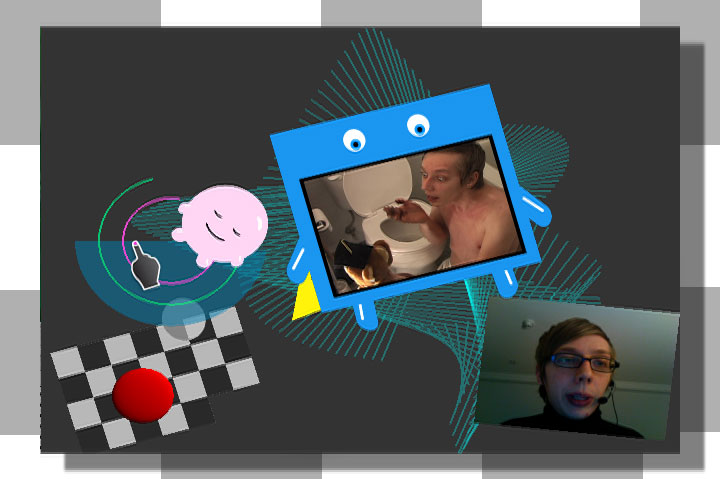
The Jeremy Bailey Show” is Bailey’s first solo exhibition in the UK and offers so much more than just “discourse analysis for dummies” (Charlotte Frost). Pop culture, pastiche and a much prettier version of the Paperclip combine, and like any good GUI, make you almost forget the technical wizardry behind them.
Jeremy Bailey received his MFA in Video Art from Syracuse University and an undergraduate degree in Visual Studies from the University of Toronto. He is co-founder of award winning artist video collective 640 480. His work has been described by Filmmaker Magazine as “a one man revolution on the way we use video, computers and our bodies to create art”. Bailey lives and works in Toronto, Canada.
Events at HTTP
Private View 7-9pm
Live Performance at 7.30pm
Your chance to meet Jeremy Bailey in the flesh and view brand new work created especially for the HTTP Gallery audience.
HTTP Gallery
Unit A2, Arena Design Centre
71 Ashfield Road
London N4 1LD
+44(0)79 8129 2734
Click here for map and location details
Musical workshops inspiring a sense of wonder in the endless combinations of sounds and rhythms in poetry, song and nature.
Participants: 90 students between the ages of 10 and 14 from Horsenden Primary School.
Artist: Michael Szpakowski (video artist, composer and facilitator)
90 students between the ages of 10 and 14 from Horsenden Primary School engaged in an exploration of the seasons through spoken/sung words and rhymes, and collaborated to create a collection of musical pieces using a variety of musical instruments. This project supported children’s reading ability by exploring rhythm through music, as well as the creation of a permanent sound artwork for the school garden that changed with the seasons to inspire a sense of wonder in the endless combinations of sounds and rhythms in poetry, song and nature.
The artist Michael Szpakowski worked with 14 small groups of pupils doing music and sound drawing on quotes from nursery rhymes and using a range of stimulating and unusual ways of making sounds. The work was digitally recorded in order to create a “generative” piece of music and sound-scape. Generative means that the computer is programmed to play back the fragments of the sound in a semi-random order so that they would constantly unfold and combine in different ways, like a kind of musical kaleidoscope.
Partners:Creative Partnerships, Horsenden Primary School.
Jeremy Bailey will be working as Artist in Residence at HTTP, Furtherfield’s Gallery and lab space, in Summer 2008. As part of the residency HTTP Gallery has commissioned a new satirical performance called Warmail which is the central piece in Bailey’s upcoming HTTP exhibition, The Jeremy Bailey Show in Autumn 2008.
The Jeremy Bailey Show, Bailey’s first solo exhibition in the UK, will present many of Bailey’s most recent works including VideoPaint 3.0 and SOS, alongside the new commission, Warmail, produced during his adjunct residency. This brand new performance work pokes fun at the value placed on “collaboration” in today’s art practice and policy-making. The performance will be staged live at the exhibition opening (Friday 19 September 2008, 7:30pm) and documented for viewing throughout the exhibition. Bailey plans to co-demonstrate, with his audience, new collaborative software that will allow participants to perform office related tasks such as email, word processing, or spreadsheets together while simultaneously composing a visual/musical score with matching choreography.
Jeremy Bailey received his MFA in Video Art from Syracuse University and an undergraduate degree in Visual Studies from the University of Toronto. He is co-founder of award winning artist video collective 640 480. His work has been described by Filmmaker Magazine as “a one man revolution on the way we use video, computers and our bodies to create art”. Bailey lives and works in Toronto, Canada.
New Online Work and Film Retrospective
by Richard Wright
No one is sure how many images there are on the Internet. Google has nearly a billion. Some say it is hundreds of times more than that. People say you can find a picture of anything on the Internet, as though the entire visual world is reflected there.
For How to Talk to Images, Richard Wright has compiled a database of 50,000 random Internet images as the raw content for two artworks. The Internet Speaks and The Mimeticon both explore new conceptions of the image, called for by the sheer quantity of visual information now available via the Internet.
Related events at HTTP
www.mimeticon.net
www.internetspeaks.net
A limited edition poster and an artist’s monograph have also been published to coincide with this show. For more information, click here.
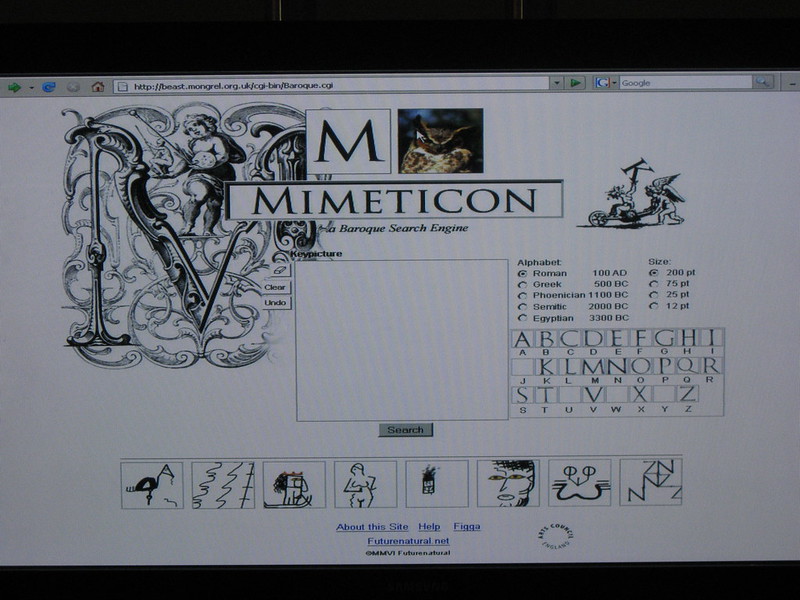
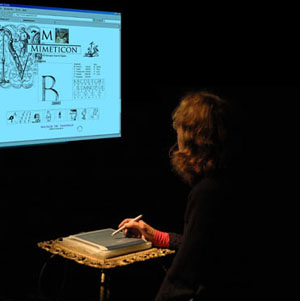
In this era, finding our way through the world of images is so overwhelming that the dominant mode is to “search” rather than to “see”. An image is an answer to a question, a search query. The Internet Speaks gives us one of the simplest imaginable ways of searching this set of images, stepping through them, one by one, in random order, without context. In contrast, The Mimeticon is a wilfully complex and ‘baroque’ search engine that allows us to search for images by visual similarity rather than by typing in keywords. These ‘search images’ are ‘drawn’ using letters from the history of the alphabet.
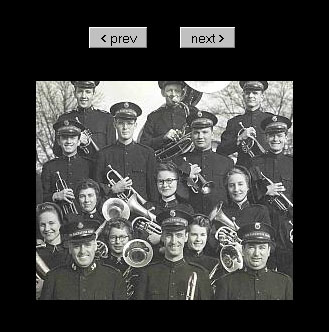
As part of How to Talk to Images, Richard Wright’s first solo exhibition in London, a selection of Wright’s animated films demonstrates the development of his current interest in the Baroque. The exhibition is also the occasion of the publication of a limited-edition poster featuring an essay by the artist illustrated by the entire visual history of the Western alphabet – from its pictorial Egyptian origins 5,000 years ago to its perfected form under the Romans, as well as a new book documenting the artists twenty-year long practice.
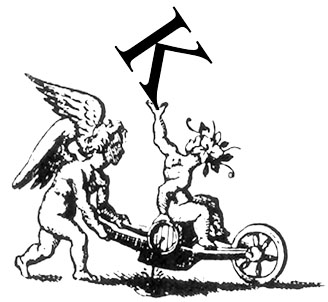
Richard Wright has been making digital animation and interactive pieces since the eighties. Heliocentrum, an animation about Louis XIV, was described by writer Hari Kunzru as “…an amazingly effective way of showing how a sovereign manipulated power”, and The Bank of Time was nominated for a BAFTA in 2001. Richard was most recently a member of the artist group Mongrel and is currently working on an urban media project called “decorative surveillance”. Since the summer of 2007, he has been Artist in Residence at Furtherfield.org.
Events at HTTP Gallery
Opening Reception
Your chance to meet Richard Wright to enjoy a few drinks and conversations about the exhibition.
HTTP Gallery
Unit A2, Arena Design Centre
71 Ashfield Road
London N4 1LD
Further info:
www.futurenatural.net
Facilitated by Ele Carpenter.
This exhibition explores the connections between the collaborative characteristics of needlework, craft and Open Source software. This project has brought together embroiderers, patchworkers, knitters, artists and computer programmers to share their practice and make new work.
Review by Jenna Ng of Critical Code Studies
Images of the exhibition
Events at HTTP
The centre-piece of the exhibition at HTTP Gallery is the HTML Patchwork developed in response to the popularity of quilting in Sheffield, the result of a participatory project initiated by Ele Carpenter in partnership with Access Space. The patchwork is built on open principles of collective production and skill-share, where each person contributes a part to the whole. The final work is a collectively stitched patchwork quilt of HTML web-safe colours with embroidered codes and a wiki website, where the makers of each patch identify themselves and write about their sewing process. Each patch is personalised by the sewer, often including embroidered web addresses.
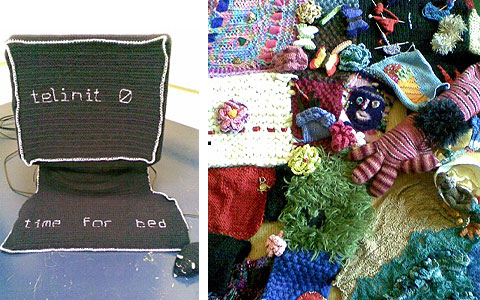
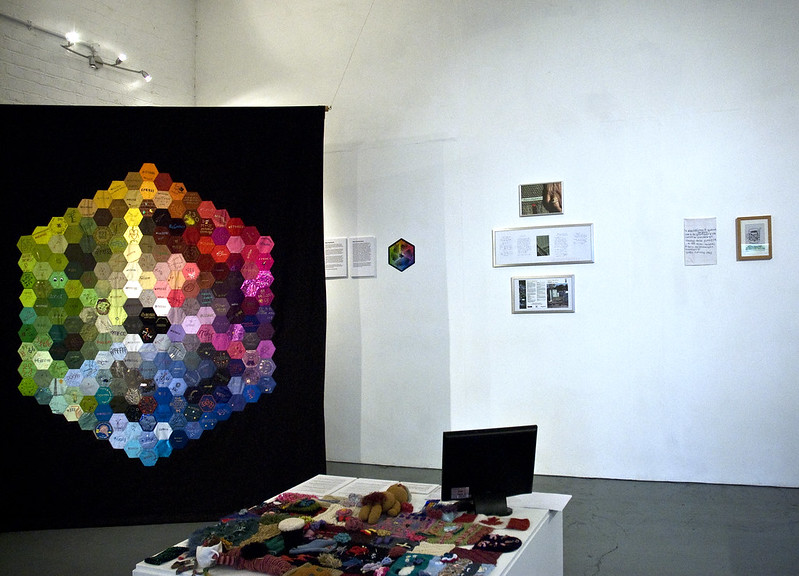
In an interview with Jess Lacetti, Ele Carpenter said about the project: “The same arguments about Open Source vs Free Software can be applied to embroidery. The needlework crafts also have to negotiate the principles of ‘freedom’ to create, modify and distribute within capitalism’s cultural and economic constraints. The Open Source Embroidery project simply attempts to provide a social and practical way of discussing the issues and trying out the practice. Free Software, Open Source, amateur and professional embroiderers and programmers are welcome to contribute to the project.”
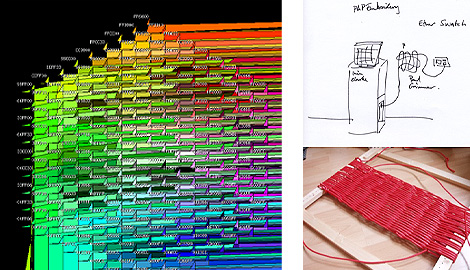
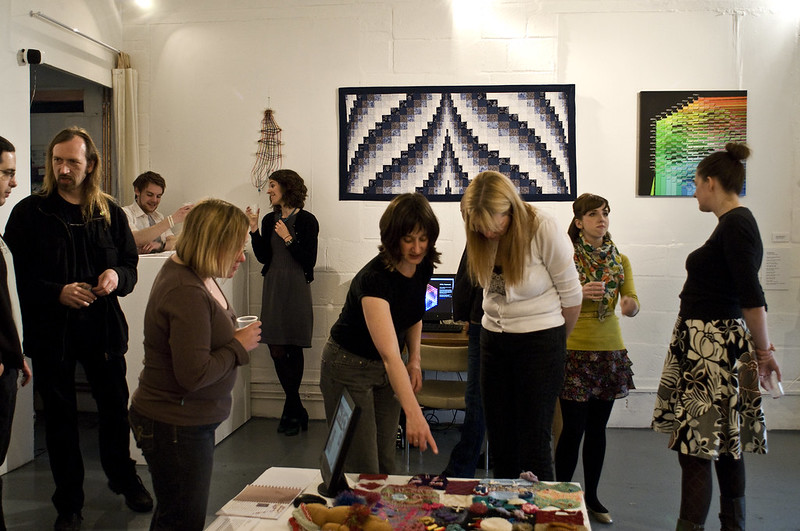
Ele Carpenter developed the project while working as an artist in residence at Access Space in Sheffield and Isis Arts in Newcastle upon Tyne. Access Space is an open-access media lab using recycled computers and open-source software. Anyone can drop in and use the lab to develop their creative projects.
The exhibition at HTTP Gallery in Harringay, North London, includes works by 11 artists and makers alongside the collectively made HTML Patchwork quilt and wiki. Other works in the exhibition include Susanne Hardy’s Knit-a-Blog, a collective knitting project made by contributors from across the UK and USA, Iain Clarke’s PHP Embroidery, which explores the open source PHP programming language as a form of self-generating weaving, as well as artworks by Paul Grimmer, Tricia Grindrod, Jake Harries & Keith o’Faoláin, John Keenan, Trevor Pitt, Clare Ruddock, James Wallbank, and Lisa Wallbank.
People at Access Space have created the HTML Patchwork. Art through Textiles, The Patchwork Garden, The Fat Quarters, Stocksbridge Knit n Chat, Totley Quilters, Isis Arts, and the Banff New Media Institute at the Banff Centre for the Arts, Alberta, Canada.
Events at HTTP
Preview
Your chance to meet Ele Carpenter, the curator and some other exhibiting artists to enjoy a few drinks and conversations about the exhibition.
Open Knitting and Embroidery evenings
Dates and times TBC
Bring your knits, your embroidery and your friends for tea, biscuits and conversation amongst the artworks.
These events are open to the public and have free entrance; however, advanced booking is necessary.
HTTP Gallery
Unit A2, Arena Design Centre
71 Ashfield Road
London N4 1LD
Further info:
www.open-source-embroidery.org.uk
www.eleweekend.blogspot.com
www.access-space.org




Rachel Beth Egenhoefer considers her Commodore 64 Computer and Fischer Price Loom to be defining objects of her childhood. She creates tactile representations of cyclical data structures in candy and knitting and is currently researching the intersection of textiles, technology, and the body.
Events at HTTP >
Other Related Events >
Rachel Beth will be working as an Artist in Residence at HTTP, Furtherfield’s Gallery and lab space in April 2008. She has been brought to UK from San Francisco as part of the Distributed South initiative, which is a network intended to raise awareness of the considerable activity in media arts in South of UK. Through residencies and collaborative events co-curated by SCAN and Space Media, Distributed South seeks to develop and build collaborations and networks in media arts and all are welcome to take part. Egenhoefer’s residency consists of several key parts – experimental studio time to create new work at the University of Brighton, presenting workshops and lectures across the south of England, a commissioned exhibition at Lighthouse Brighton, all culminating with time spent in residence at Furtherfield.
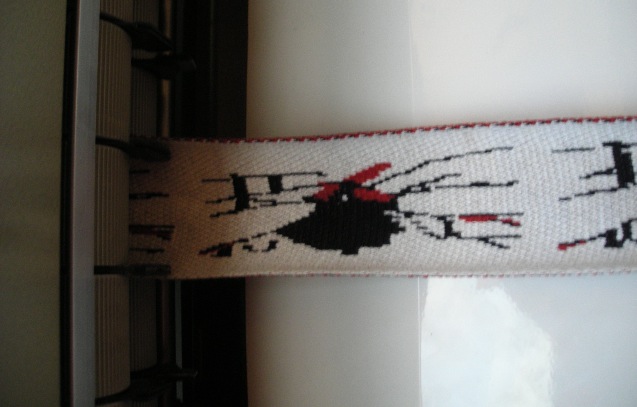
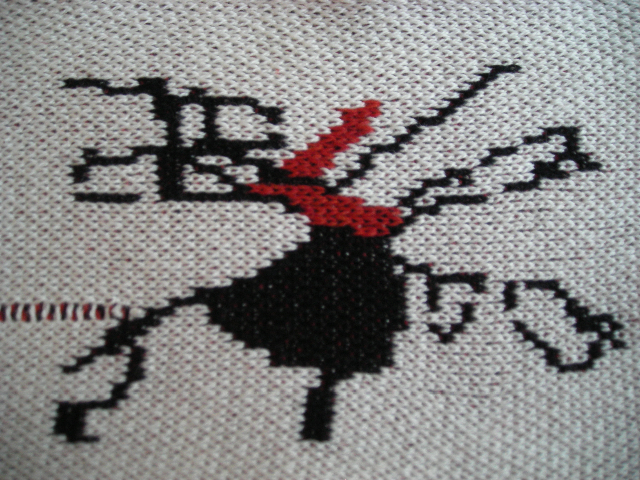
Currently Rachel Beth is working in the studio on ideas comparing tactile knitting to intangible computer code and how the body interacts and moves with both. In addition to building a knit zoetrope, casting the space between body and machine in candy, she has also been tracking the motion of knitting needles in both physical and virtual space and knitting with the Nintendo Wii. Her time at Furtherfield will be used to continue exploring these ideas while interacting with the larger community and audiences Furtherfield brings.
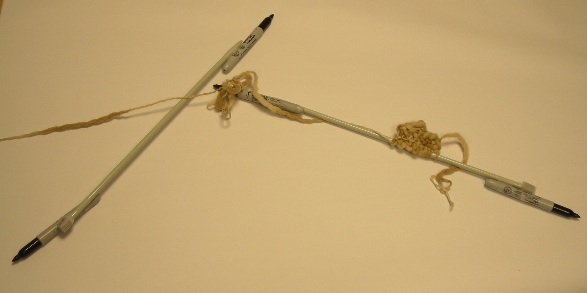
Higher Education Student Day
Wednesday April 15, 1:00-4:00pm
Rachel Beth will present her work and professional practice from the residency to higher education students
This event is free however advanced booking is necessary.
Networking Event and Residency Closing Party
Configurations: Technology and Textiles Networking Afternoon
25 April, 3.30 – 6pm, HTTP Gallery (Booking essential)
You are invited to share ideas, discuss and develop future working around art work that investigates the relationship between new technology, traditional making techniques and transformative political actions. Anna Dumitriu, Ele Carpenter, Nicola Naismith and Rachel Beth Egenhoefer will present their work using diverse approaches to the making of work using new technology alongside textiles, followed by a “Long Table Discussion”.
The “Long Table Discussion” is an experimental public forum developed by performance artist Lois Weaver. It is a hybrid performance, installation and roundtable discussion designed to facilitate informal conversations on serious topics encouraging everyone to contribute. Previous “Long Table Discussions” include conversations on Women and Prisons, Human Rights and Performance and Manufacturing Bodies.
This event is free however advanced booking is necessary. To book places please email Aaron, visibilityATfurtherfieldDOTorg.
Closing Party for Rachel Beth Egenhoefer 6pm – 9pm (all welcome): Party to celebrate the close of Rachel Beth Egenhoefer’s residency at Furtherfield/HTTP Gallery and providing an opportunity to discuss her work and experiences during the residency.
Rachel Beth Egenhoefer’s residency and Configurations is part of Distributed South an initiative co-curated by SCAN and Space Media. The residency and event is funded by the Arts Council England, University of Wales, University of Brighton, Lighthouse Brighton with support from Furtherfield.org, Textile Futures Research Group (TFRG) and University of the Arts London.
71, Ashfield Rd, London N4 1NY
Click here for map and location details
Distributed South www.distributedsouth.org.uk
www.rachelbeth.net
www.elecarpenter.org.uk
www.nicolanaismith.co.uk
www.annadumitriu.co.uk
Candy & Code
Institute of Contemporary Art (ICA) London _Textile Futures Research Group
Monday March 17, 2008, 6:30-8:30pm
Presentations from Rachel Beth Egenhoefer, Barbara Rauch & Nicola Naismith
Following by a panel discussion with the artists and Dr Jane Harris, Director of TFRG, Helen Sloan, Director of SCAN.
Exhibition of New Work
Lighthouse Brighton
March 20- April 5, 2008
Opening Reception: Thursday March 20, 6:00-9:00pm
Talk on Residency and Distributed South (with Rachel Beth Egenhoefer and Helen Sloan) with an opportunity to view the exhibition: Thursday March 27, 7:30pm, doors open at 7
Rachel Beth’s residency for Distributed South is funded by the Arts Council England, University of Wales, University of Brighton, Lighthouse Brighton and supported by SCAN, Space Media, Furtherfield.org, Textile Futures Research Group (TFRG) and University of the Arts London.
The exhibition was curated by critical game theorist Corrado Morgana in partnership with Marc Garrett and Ruth Catlow Furtherfield’s HTTP Gallery. It included works by Axel Stockburger, TheGhost, Corrado Morgana, Ziga Hajdukovic, Progress Quest and JODI. The exhibition was accompanied by a short publication with a keynote text by Axel Stockburger.
Zero Gamer positions itself as a meaningful interruption of the playing process in order to facilitate a platform for reflection. The works addressed different aspects of digital gameplay, although they did not take the form of playable games themselves. Rather, their purpose was to allow the audience to engage with different crucial issues arising from the hugely complex field of games and gaming but without actually playing. The artists employed different strategies to enable this, ranging from intervening with mechanics such as artificial intelligence and in-game physics to removing game tokens and hazards enabling discussions about the meaning of player engagement. Zero Gamer does not stand for a return to more traditional forms of aesthetic production. On the contrary, it points in the opposite direction, placing itself as the necessary interstice between gaming cycles.
Zero Gamer was first presented by HTTP Gallery at the London Games Festival Fringe in 2007. The remixed exhibition, Zero Gamer (GOLD) was on show at HTTP Gallery between 2-18 November 2007.
Zero Gamer text by Ruth Catlow, Marc Garrett (HTTP/Furtherfield.org) and Corrado Morgana 2007.
On Archive.org – Wayback machine – https://bit.ly/3ya6nqe
List of artworks
Mario Trilogy: Mario battle no.1 (2000), Mario is drowning (2004) and Mario is doing time (2004). by Myfanwy Ashmore
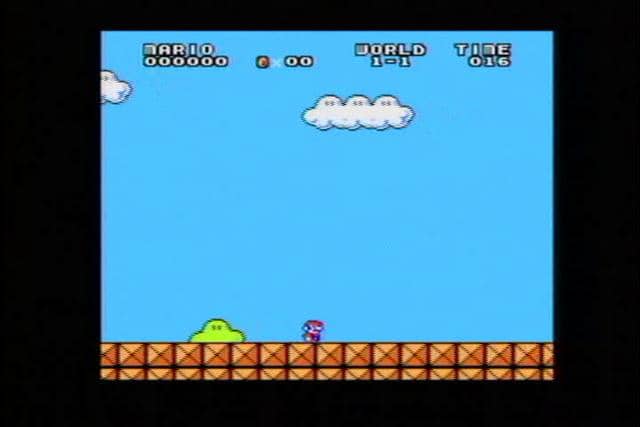
Max Payne Cheats Only (2004). By JODI
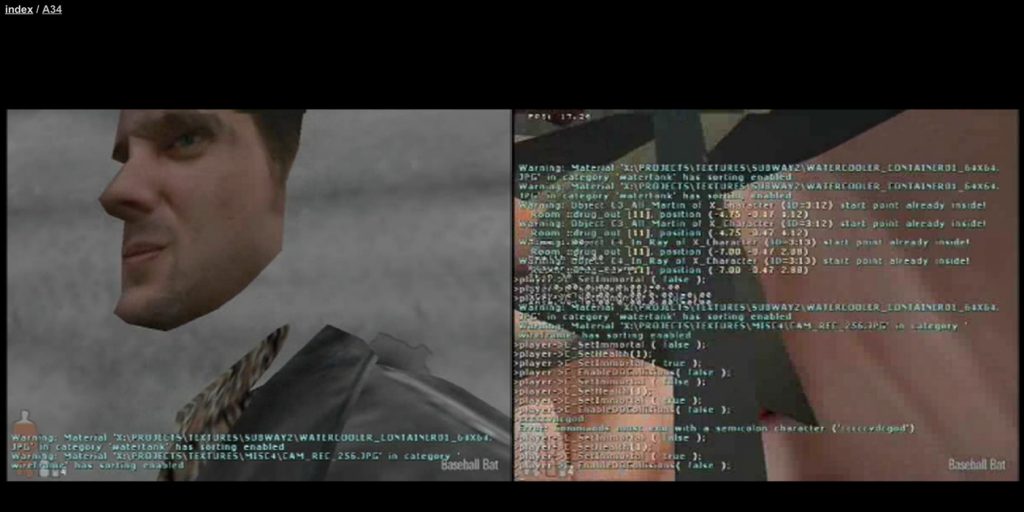
Boys in the Hood (2006). By Axel Stockburger
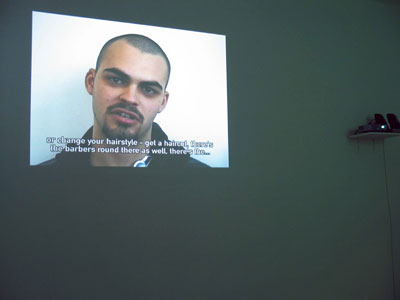
CarnageHug (2007). By Corrado Morgana
Progress Quest (2004). By Eric Fredricksen
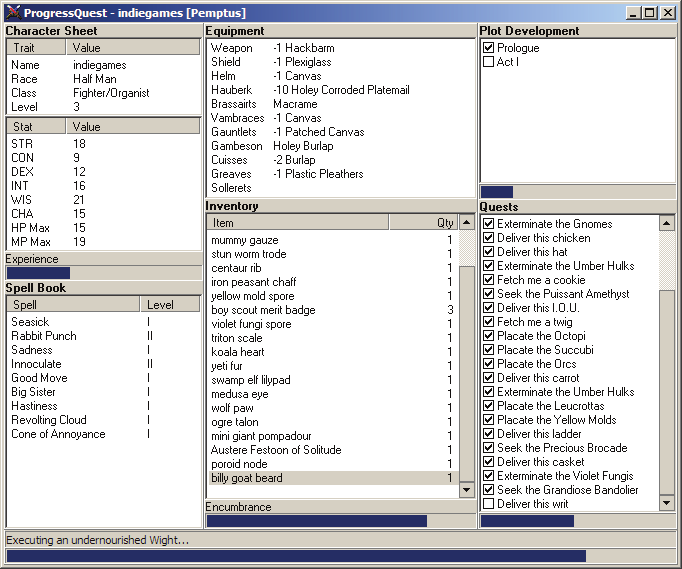
1d Tetris (2002). By Ziga Hajdukovic

Youtube Showreel
Breen and Alyx by Wo0Yay
Launch Line by TheGhost
Real Action Tetris by Mega64
Hamster Video Game uploaded by Jason the Vid Guy
Tetris The Absolute The Grandmaster2 Plus Death Mode uploaded by madeofwin
Space Invaders in Real Life uploaded by ChugaTheMonkey
Self-playing Mario by Diagram
TAS video – Megaman 3,4,5 and 6 by Angerfist and Baxter
Exhibition Images
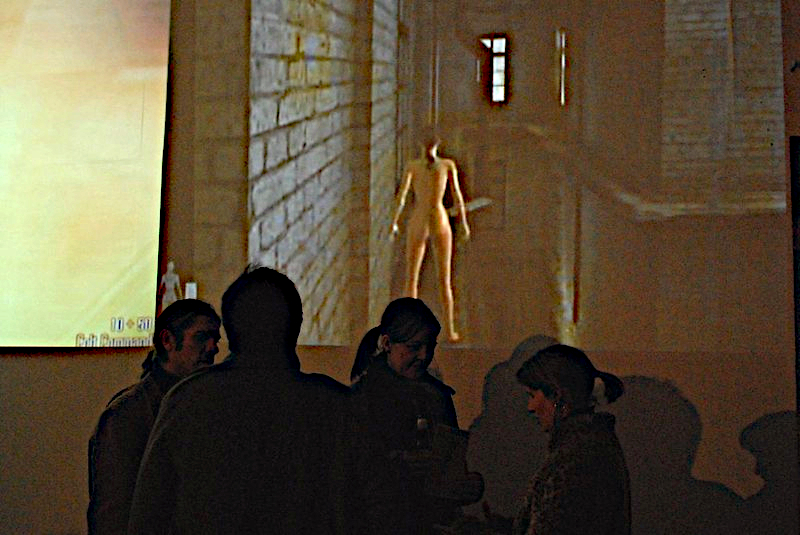
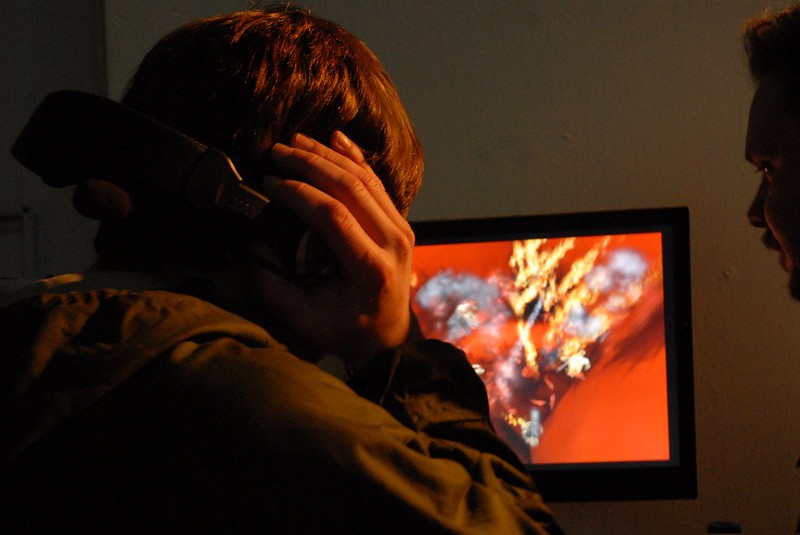
Workshops to create and film a drama promoting an enthusiasm for maths at Mayfield Primary School.
Participants: 28 children aged 8-9 years old from Mayfield Primary School
Artist: Michael Szpakowski (video artist, composer and facilitator)
In a series of workshops to promote an enthusiasm for maths within the school, a class of children aged 8-9 years old created and filmed a drama in 9 parts in which they cracked a series of knotty maths problems that they encountered during a school day. Pupils puzzle and ponder over how many minutes they have before they have to leave for school, how to organise rows and columns for school assembly, how it feels to crack a hard Maths problem. These short films, where we see the pupils trying to work out maths problems together, continue to serve as playful teaching tools within the school.
Partners:Creative Partnerships, Mayfield Primary School.
Featured image: A database of 50,000 random Internet images.
Richard Wright will be working as Artist in Residence at HTTP, Furtherfield’s Gallery and lab space for one year, from Summer 2007 to Spring 2008. The residency will culminate in a HTTP Gallery exhibition, How To Talk To Images, featuring a retrospective of computer animations and a new online work drawing on a database of 50,000 random Internet images.
Richard Wright has been making digital animation and interactive pieces since the eighties. Heliocentrum, an animation about Louis XIV, was described by writer Hari Kunzru as “…an amazingly effective way of showing how a sovereign manipulated power” and The Bank of Time was nominated for a BAFTA in 2001. Richard was most recently a member of artists group Mongrel and is currently working on an urban media project called “decorative surveillance”.
For How to Talk to Images, Richard Wright plans to compile a database of 50,000 random Internet images as the raw content for two artworks. The Internet Speaks and The Mimeticon both explore new conceptions of the image, called for by the sheer quantity of visual information now available via the Internet. The exhibition will also be the occasion of limited-edition poster featuring an essay by the artist illustrated by the entire visual history of the Western alphabet – from its pictorial Egyptian origins 5,000 years ago to its perfected form under the Romans, as well as a new monograph documenting the artists twenty year long practice.
An E-Mail-Art project on the NetBehaviour email list culminating in an exhibition at the HTTP Gallery in London.
Open Call for contributions from 31 January to 28 February 2007 via NetBehaviour email list.
Images from the show are – https://www.flickr.com/photos/http_gallery/albums/72157624491759868
Exhibition at HTTP Gallery in March 2007
The Do It With Others (DIWO) E-Mail-Art project aims to highlight the already thriving imaginations of those who use social networks and digital networks on the Internet as a form of distribution. Just like Mail Art, E-Mail-Art bridges the divide between artists and non-artists to share a freely accessible form of distribution.
The Mail Art projects of the 60s, 70s and 80s demonstrated Fluxus artists’ common disregard for the distinctions of ‘high’ and ‘low’ art and a disdain for what they saw as the elitist gate-keeping of the ‘high’ art world. They often took the form of themed, ‘open calls’, in which all submissions were exhibited and catalogued. Mail Art has always been a useful way to bypass curatorial restrictions for those who wish to create active and imaginative exchange on their own terms; this form of activity usually flourishes outside of the gallery system.
This E-Mail-Art project intends to follow the spirit of past Mail Art endeavours by asking those submitting their works to open themselves to a shared dialogue as part of the process and medium on the NetBehaviour mail list, as a playful platform for experimentation together at the same time.
The theme of this E-Mail-Art project is Do It With Others (DIWO).
This project suggests that we extend the DIY ethos of some early net art and tactical media (said to be motivated by curiosity, activism and precision) towards a more collaborative DIWO approach. Peers connect, communicate and collaborate, creating controversies, structures and culture using both digital networks and shared physical environments.
You are invited to contribute and curate text, images, sound, net movies, physical objects, installation plans etc. on the theme of DIWO, only via the NetBehaviour email list, towards an open exhibition at the HTTP Gallery in London that opens in March ’07.
To participate in Do It With Others (DIWO): E-Mail-Art at NetBehaviour please join the NetBehaviour email list: http://www.netbehaviour.org/mailman/listinfo/netbehaviour
What Will Happen?
All posts to the NetBehaviour email list between 31st January and 1st April 2007 will be considered part of the artistic and curatorial project. In the spirit of early Mail Art Do It With Others (DIWO): E-Mail-Art at NetBehaviour is completely open. For the HTTP Gallery contributors are be invited to propose works for networks, computers, screens, projection, sound, print…
31 January 2007: Contributions to Netbehaviour email list begin.
List members are invited to devise their own ordering and selection strategies for the exhibition.
25 February 2007, 2 – 5pm GMT: Collaborative Curation Event
Open review of contributions and discussion about the exhibition. The event will be available for viewing and interaction from the HTTP gallery. List contributions thus far will take physical form as an exhibition. Discussions using IM (chat) between Furtherfielders and other active contributors. Documented and posted to the list.
1 March 2007: Gallery Opening of Do It With Others (DIWO): E-Mail-Art at NetBehaviour
1 March – 1 April 2007: Continue to shape the exhibition via the email list by contributing more work, suggesting things be taken down, put back up, rearranged, anything!
1 May 2007: All contributions documented in a catalogue available as a pdf download.
The project will also be documented in the NetBehaviour email list archive and a blog maintained by Furtherfield newcomer Lauren Wright – LaurenDIWO’s Blog.
Do It With Others (DIWO): E-Mail-Art at NetBehaviour project by Ruth Catlow, Marc Garrett and Lauren Wright for Furtherfield in collaboration with all contributors to the NetBehaviour email list.
5 short movies by 5 film makers about 5 networked art projects exploring imaginative and critical approaches to social engagement.
Furtherfield has commissioned 5 short movies about 5 UK-produced networked art projects which explore critical approaches to social engagement. These pieces offer alternative interfaces to the artworks and the every-day artistic practices of their producers. They introduce the motivations and social contexts of artists and artists’ groups who are working with DIY approaches to digital technology and its culture, where medium and distribution channels merge.
Original concept and production Furtherfield, London, UK. 2006
In association with HTTP Gallery [House of Technologically Termed Praxis], London, UK.
Made with the support of Stiftelsen Längmanska Kulturfonden and Mejan Labs in Stockholm, Sweden – Arts Council England and Awards for All in UK.
Free Media by Mongrel
This movie focuses on Mongrel’s digital workshop project, the MediaShed in Southend on Sea, 65 km east of London, where anyone can come to seek knowledge, use computers, suggest projects and attend lectures. More info >>
View movie >>
Polyfaith by Chris Dooks
Polyfaith.com provides a printable map and mp3 files to accompany a free tour of of his home town Edinburgh seen through the eyes of an unusual local character. In this short movie Polymath he introduces the beliefs and philosophies of his friend Erica Tetralix, as explained through the city’s landmarks. More info >>
View movie >>
VisitorsStudio by Furtherfield
This movie is about VisitorsStudio, an online place for real-time, collaborative, audio-visual mixing and networked performance, a tool for editing movies and images live with other people online. More info >>
View movie >>
Want and Need by C6
The London based artist group C6 believes in communication through action and the importance of creating alternatives to established uses of new technologies. Their project Want & Need is shown in Mejan Labs during autumn 2006 and has earlier been on a tour through Norway as well as being shown in New York, London and Eindhoven. More info >>
View movie >>
Golden Shot (Revisited) by Simon Poulter
The Golden Shot was a game show in British television in the 1960- and 70’s. The idea with the show was that the audience called the show to play a game and gave instructions to a camera man how to aim his camera to different targets. On the camera there was a cross bow attached. More info >>
View movie >>
Date: 31 August – 8th October 06.
Art & Activism Exhibition.
Mejan Labs. Stockholm. Sweden.
http://www.mejanlabs.se/article_en.asp?ID=54&KAT=CURREX&templ=2
Date: 3rd October 06.
Being Digital. Greenwich University. London. UK.
Date: December- date to be confirmed.
HTTP Gallery. 5+5=5 UK launch. London. UK.
http://www.http.uk.net/
Date: November – date to be confirmed.
MediaShed – Mongrel. Southend on Sea, Essex. UK.
http://mediashed.org/
Please contact us for details if you wish to show or screen 5+5=5 at a venue.
Game/Play exhibition at HTTP Gallery
22 July – 3 September 2006
Game/Play is a national touring exhibition that explores goal-orientated gaming and playful interaction through media arts practice. This collaboration between Q-Arts, Derby and HTTP, London has provided a framework to develop a context for creative exchange between visitors to the exhibition focusing on the rhetorical constructs game and play. Projects fall under three main categories: installations, independent video games and online (networked) artworks. Download the catalogue in pdf format https://www.academia.edu/1470002/Game_Play_2006_
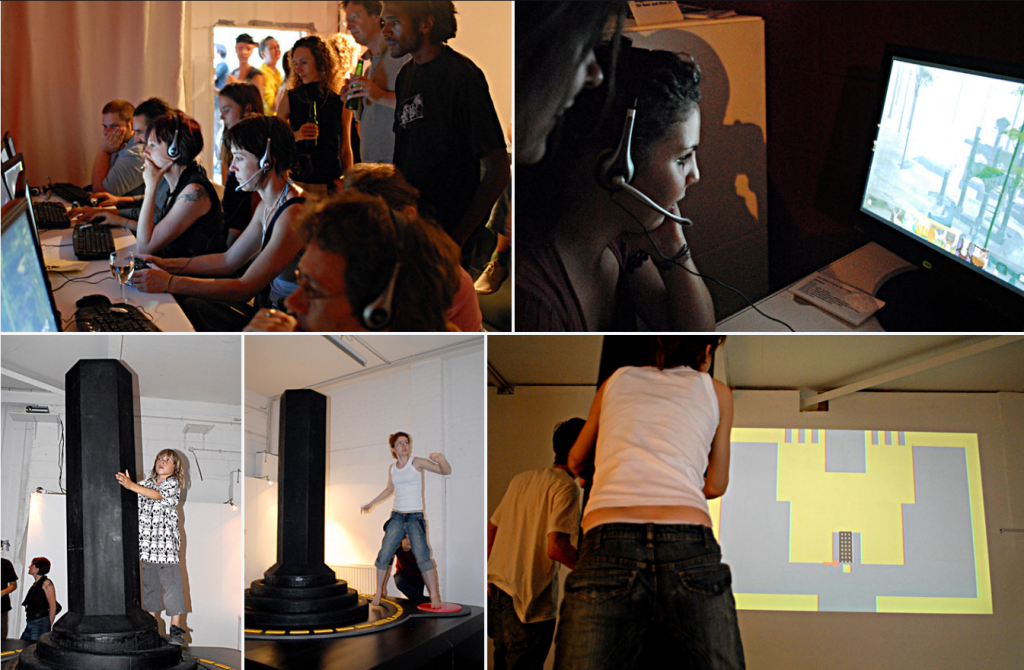
[giantJoystick] by American ‘girl gamer’ Mary Flanagan has been specially commissioned by HTTP for this exhibition. Alongside this installation, HTTP presents independently produced video games selected by curator Corrado Morgana for their divergence from commercial game-types and online participatory artworks Tale of Tale’s Endless Forest and Furtherfield.org’s VisitorsStudio.
[giantJoystick] offers a humorous reworking of the multi-player game. Visitors are invited to collectively play classic arcade games with a nine foot tall joystick modelled after the Atari 2600 one. The competitive goals of these classic arcade games are already familiar, however the dramatic change in scale of the joystick necessitates both an encounter of the whole body with the artwork and cooperation between a number of players in order to reach them.
Two of the independent video games Kenta Cho’s Noiz2sa and Julian Oliver’s 2nd Person Shooter are both shooters. Kenta Cho’s Noiz2sa is a retro shoot ’em up while Oliver’s is a a wry riff on First person Shooters. Oliver’s game-demo places the gamer behind the eyes of a murderous bot over which they have no control and which is set on destroying them. Players are not only hunted, but also have to quickly adopt a new logic for operating where their perspective is no longer attached to their body, the customary instrument of their will.
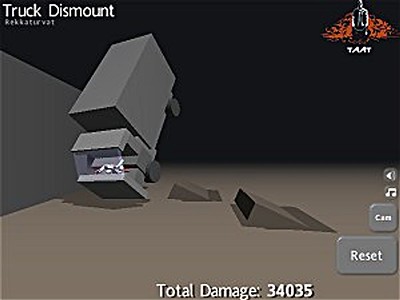
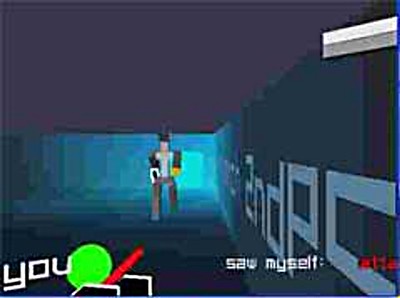
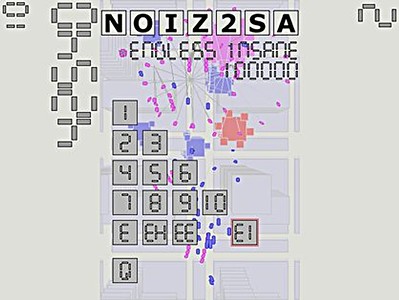
Jetro Lauha’s Truck Dismount presents us with a simple 3-dimensional world including a truck, some ramps, a wall and a crash test dummy called DJ. An example of physics gaming, which uses physical interactions as their primary basis, Truck Dismount examines the guilty pleasures of transgressive behaviour.
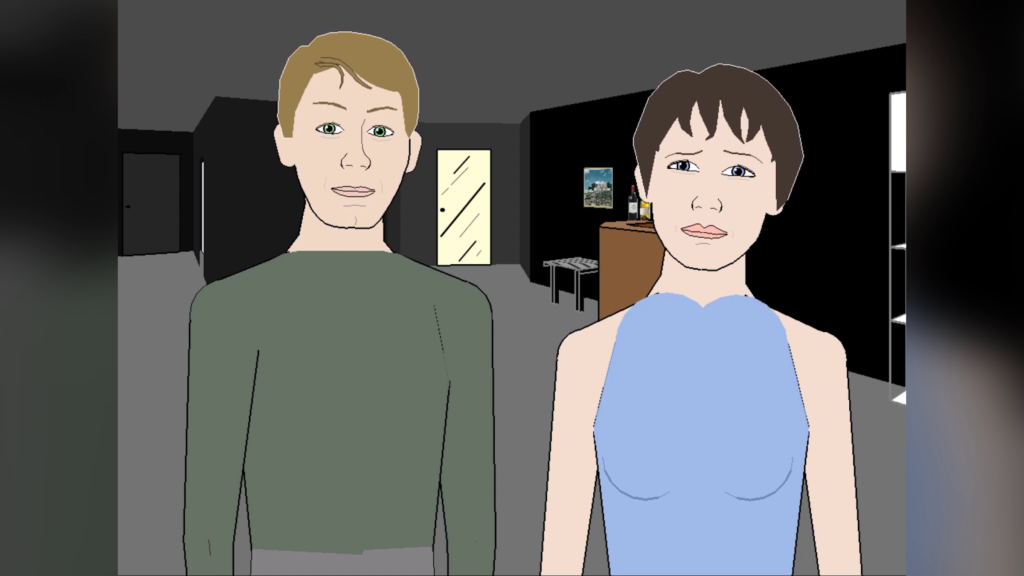
Façade is an artificial intelligence-based art/research experiment in electronic narrative. Michael Mateas and Andrew Stern have fused the hyperlink with the one-act drama to engineering a novel architecture for supporting emotional and interactive character behaviour.
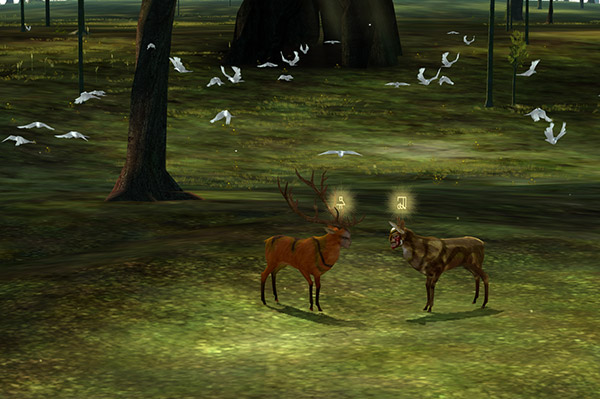
Tale of Tale’s Endless Forest and Furtherfield.org’s VisitorsStudio use the Internet as a networked, platform for real-time, collaborative play and online performance and they provide connecting spaces between audiences at HTTP & Q Arts galleries. VisitorsStudio is an online arena for real-time, multi-user mixing, networked performance and play. Endless Forest is described by the artists as a “social screensaver”, audiences join other players, in real-time downtime to inhabit the bodies of deer, roaming in a lush virtual landscape.
Game/Play is a collaboration between Q-Arts, Derby and HTTP, London that explores goal-orientated gaming and playful interaction through media arts practice.
From 22 July to 3 September, HTTP presents a new commission [giantJoystick] by American ‘girl gamer’ Mary Flanagan, independently produced video games selected by curator Corrado Morgana for their divergence from commercial game-types and online participatory artworks by Tale of Tales and Furtherfield.org.
The works exhibited at Q Arts from 22 July to 10 September create spaces for socio-dramatic play through physical action and response. Q Arts has commissioned artists such as Simon Poulter and Low Brow Trash to create socially engaged art games, which will be presented alongside games created for the commercial industry.
http://www.game-play.org.uk
http://www.http.uk.net
http://www.q-arts.co.uk/
Game/Play opens at a simultaneous launch event at Q Arts and HTTP galleries. Enjoy the Ermajello performance of Plankton at Q Arts, test drive Mary Flanagan’s [giantJoystick] at HTTP, view the works and connect and collaborate with visitors in both galleries in the online, multiuser spaces of Furtherfield’s VisitorsStudio and Endless Forest by Tale of Tales. Game/Play will tour as a combined exhibition from September 2006 – January 2008 with a series of online events.
21 July 6.30pm – 8.30pm Q Arts – Gallery
35/36 Queen Street, Derby, DE1 3DS
22 July 7pm – 9pm
HTTP, London
Unit A2, Arena Business Centre,
71 Ashfield Rd, London N4 1NY
A series of online events, performances and workshops will create opportunities for more directed interaction between gallery visitors and remote audiences at Q-Arts and HTTP between July and September 2006. Visit http://www.game-play.org.uk for full details.
The team behind the project is Giles Askham (curator and coordinator), Corrado Morgana (independent curator), Louise Clements (Q Arts), Ruth Catlow and Marc Garrett (HTTP). Game/Play is funded by Arts Council England and Awards For All.
HTTP [House of Technologically Termed Praxis]’s main remit is to offer a physical interface to networked art projects thus creating a social space in which people can interact with artworks and each other. It was opened on the initiative of Furtherfield (http://www.furtherfield.org) in the vibrant and culturally diverse Green Lanes area of North London. HTTP works with a wide range of artists and audiences to explore the potential of network technology and to promote distributed creativity. HTTP is supported by Arts Council of England.
Opening hours: Friday to Sunday 12noon-5pm
Tube: Manor House Buses: 29, 67, 141, 253, 254, 259, 341 Train: Haringey Green Lanes
www.http.uk.net
This project is supported by Arts Council England (London), Q Arts, Awards For All, Derby City Council, QUAD, Http and Furtherfield.org.
June 2006
HTTP Gallery is pleased to present Urban Eyes, an intermedia project by Marcus Kirsch and Jussi Angesleva. Urban Eyes uses wireless technology, bird seeds and city pigeons to reconnect urban dwellers with their surroundings.
The Urban Eyes feeding platform stands in one of London’s public spaces. By landing on the platform, pigeons tagged with RFID chips send aerial photographs of their locality to surrounding Bluetooth-enabled devices. In this work pigeons become maverick messengers in the information super-highway, fusing feral and digital networks. HTTP Gallery provides an interface to the project, mixing live and documentary footage and offering visitors an opportunity to experiment with Bluetooth.
Being one of the last remaining signs of nature in a metropolis such as London, the urban pigeon population represents a network of ever-changing patterns more complex than anything ever produced by a machine. However, pigeons’ movements are based on a one-mile radius around their nest. Any pigeon you see every day shares the same turf as you. Urban Eyes crosses and expands human mobility patterns offering to reconnect you with your neighbourhood.
In the 1960s, situationists Debord and Jorn composed psycho-geographic diagrams of Paris, which described navigational systems based on their drift through the city. For this, they used Blondel la Rougery’s Plan de Paris a vol d’oiseau, a birds-eye map of Paris. Inspired by this methodology, Urban Eyes enlists our feathered neighbours to establish a connection between this view of the city as now distributed by Google Earth and our terrestrial experience.
About Marcus Kirsch and Jussi Angesleva
Marcus Kirsch holds an MA in Interaction Design from the Royal College of Art. He was invited to the 2004 Seoul Biennale and as exhibiting artist and to last year’s Rotterdam International Film Festival and DEAF Festival. He was awarded a silver Art Directors Club NY and a fusedspace.com award in collaboration with Jussi for ‘Urban Eyes’.
Jussi Angesleva holds MA in Audio Visual Media Culture from the University of Lapland in Finland, and MA in Interaction Design from the Royal College of Art and has shown at the Tokyo Metropolitan Museum of Photography, Siggraph, ZKM and Science Museum London. He has received awards from the Royal Society of Arts, NESTA, D & AD (together with Ross Cooper), Prix Ars Electronica and the Art Directors Club of Europe. He is currently working at ART+COM in Berlin, Germany and is a co-founder of the new media agency Prosopon.

American ‘girl gamer’ artist and theorist, Mary Flanagan will be working as Artist in Residence at HTTP, Furtherfield’s Gallery and lab space in Spring 2006. As part of the residency HTTP Gallery has commissioned [giantJoystick] for the Game/Play exhibition, a national touring exhibition, in collaboration with Q-Arts (now Quad), Derby, which explores goal-orientated gaming and playful interaction in media arts practice.
[giantJoystick] offers a humorous reworking of the multi-player game. Visitors are invited to collectively play classic arcade games with a nine foot tall joystick modelled after the Atari 2600 one. The competitive goals of these classic arcade games are already familiar, however the dramatic change in scale of the joystick necessitates both an encounter of the whole body with the artwork and cooperation between a number of players in order to reach them.
Mary Flanagan is an artist, author, educator, and designer. Known for her theories on playculture, activist design, and critical play, Flanagan has achieved international acclaim for her novel interdisciplinary work, her commitment to a theory/practice dialogue, and contributions to social justice design arenas. Her research examines the boundaries between the personal and the public, perception, power, and what technology can teach people about themselves. Using the formal language of the computer program or game to create systems which interrogate seemingly mundane experiences such as writing email, using search engines, playing video games, or saving data to the hard drive, Flanagan reworks these activities to blur the line between the social uses of technology, and what these activities tell us about the technology user themselves. Her artwork ranges from game based systems to computer viruses, embodied interfaces to interactive texts; these works are exhibited internationally at venues including the Laboral Art Center, Whitney, SIGGRAPH, Beall Center, The Banff Centre, The Moving Image Center, Steirischer Herbst, Ars Electronica, Artist’s Space, Guggenheim, Incheon Digital Arts Festival, and and venues in Brazil, France, UK, Canada, Taiwan, New Zealand, and Australia.
9 March – 22 April 2005.
SPIO is a ‘self-surveilled’ system based on a robotic device designed for capturing and processing images from a different perspective.
An autonomous vacuum cleaner equipped with high sensibility and infra-red CCTV cameras scans the installation space through pre-defined movements and triggers sound and visual events.
In the UK, one of the most visible interactions of place and high-technology communications systems over the past 10 years has been the installation of Closed Circuit Television (CCTV). Designed to improve the economic fortunes of public, commercial street systems, such technologies are so widespread that it has been estimated that the average UK urban resident is now monitored more than 300 times a day, making Britain the most visually surveilled nation on Earth.
Artists working in digital media are increasingly exploiting the subject of CCTV. Lucas Bambozzis SPIO, now installed at HTTP gallery, is an autonomous vacuum cleaner equipped with high sensibility and infrared CCTV cameras. SPIO scans the exhibition space through pre-defined movements and triggers sound and visual events in the ambient. The work is making an ironical comment on the self-surveyor apparatus, based on apparently innocent gadgets that will be filling our homes and habits more and more.- Tobi Maier

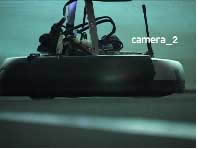
The CCTV cameras were installed in the robot.
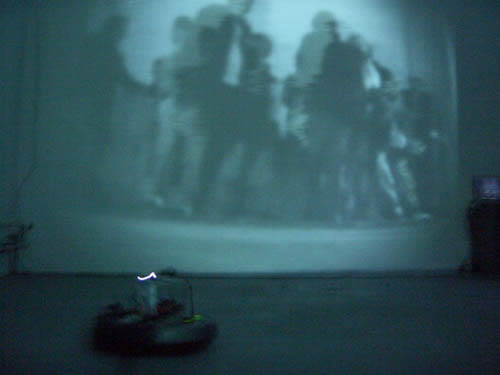
Credits and technical details
Concept, creation and direction: Lucas Bambozzi
Music: Radboud Mens
Technical production in UK: Giles Pender for Furtherfield
Original Setup
Software development: Caio Barra Costa
Hardware and technical production: Fábio Seiji Massui
Originally presented at Emoção Art.Ficial 2.0 Itaú Cultural, São Paulo Brazil
Presented at Emoção Art.Ficial 2.0 Itaú Cultural, São Paulo Brazil – July to September 2004.
Curated by: Tobi Maier and Furtherfield
9th March – 22nd April 2006
HTTP Gallery is pleased to present Open Vice/Virtue: The Online Art Context a solo show by American artist Andy Deck, as part of NODE.London season. For this, his first exhibition in London UK, Deck uses the Internet, the gallery and public space to challenge corporate control over communication, tools and software, and by extension the social imagination.
‘The giantism of media corporations and the ongoing deregulation of media consolidation (Ahrens), underscore the critical need for independent media sources. If it were just a matter of which cola to drink, it would not be of much concern, but media corporations control content. In this hyper-mediated age, content — whether produced by artists or journalists — crucially affects what people think about and how they understand the world. Content is not impervious to the software, protocols, and chicanery that surround its delivery. It is about time that people interested in independent voices stop believing that laissez-faire capitalism is building a better media infrastructure.’ Andy Deck

Glyphiti is an online collaborative drawing project resented uniquely at HTTP. A large-scale projection forms an evolving graffiti wall and visitors to the space are invited to edit and add graphical units or ‘glyphs’, which compose the image, in real-time. The marks made by each person, combine with others and are shown as a time-lapse image stream. Hanging fabrics being shown here for the first time provide a tactile document of recent years’ of Glyphiti. Unlike most image software available on the Internet, Glyphiti functions through most corporate firewalls by using standard Web server requests. For the artist, penetrating firewalls acts as a metaphor for graffiti making: both activities necessitate the appropriation of privatised space for visual play.
Imprimatur consists of an online ‘groupware’ for poster illustration and layout accessible through a computer workstation installed in the gallery space. Visitors can use the software to create their own posters in collaboration with their online counterparts. This piece provides a framework for visitors/participants to launch a personal poster campaign based on their own social and political concerns. This DIY approach revives the tradition of poster-making as a medium of mass communication and persuasion developed during the 20th century. The posters will by displayed as part of the exhibition and will circulate freely beyond the gallery walls, appearing in surrounding streets, schools, libraries, kitchens and bedrooms.
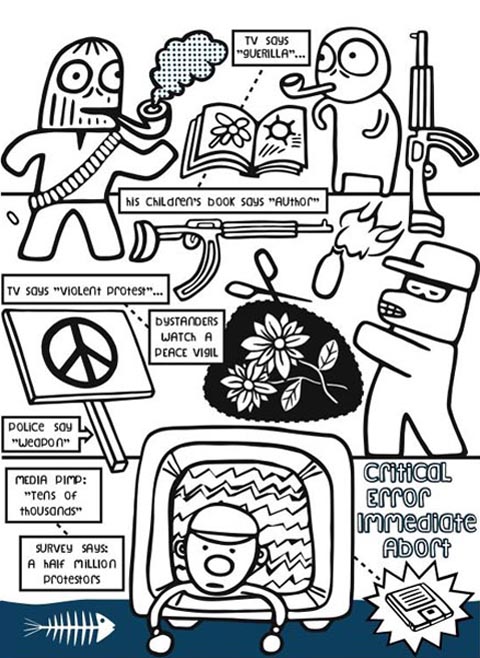
Panel Junction combines the graphic novel with forms of shared authorship that have been made possible by the Internet. Here the artist selects a few stories emailed to him by visitors from all around the world. Each of the stories is chosen as a sequel to the most recent one and is transformed into a graphic novel by the artist. Hard copies will be available at the HTTP space for visitors.
Andy Deck presents his works at the Science Museum’s Dana Centre.
On Wednesday March 8 Andy Deck will be presenting his work at the Science Museum’s Dana Centre. The evening will be split into two parts: 17.30 -18.30 Screenings of key interactive works that you can get involved within real-time, and an informal opportunity to meet the artist with the HTTP Curators, Marc Garret and Ruth Catlow. 19.00 – 20.30 presentation by the artist of his work. Both events will be free and will be in the Dana Centre cafe bar. For details of this event www.danacentre.org.uk
“Leading American artist Andy Deck and HTTP Gallery are important independent voices in the new cultural communication space we call ‘the Internet’.” – Hannah Redler, Head of Arts Programme, Science Museum.
About Andy Deck
Andy Deck makes public art for the Internet that resists generic categorisation: collaborative drawing spaces, game-like search engines, problematic interfaces, informative art. Deck has made art software since 1990, initially using it to produce short films. Since 1994, he has worked with the Web using the sites www.artcontext.com and www.andyland.net
In addition to online commissions from New Radio and Performing Arts, Rhizome.org, the Whitney Artport and the Tate, Deck has shown his work in a variety of exhibitions in places like the Machida City Museum (Tokyo); the ZKM (Karlsruhe); PS1 (NYC); the MACBA (Barcelona); the Moving Image Gallery (NYC); Postmaster’s Gallery (NYC); the Walker Art Center (Minneapolis), and the Ars Electronica Center (Linz). Andy studied for a Post-diplôme, at the Ecole Nationale Supérieure des Arts Décoratifs, Paris; and received his MFA in Computer Art at the School of Visual Arts (SVA), NYC. He has taught at the Universidad Internacional Menéndez Pelayo, Sarah Lawrence College, and New York University, the School of Visual Arts, and most recently the iEU Faculty of Fine Art and Design in Izmir, Turkey.
Notes for editors:
Title: Open Vice/Virtue: The Online Art Context
Artist: Andy Deck
Dates: Exhibition and associated events at HTTP 9th March – 22nd April 2006
Screening and presentation of works at Science Museum’s Dana Centre 8th March 5.30-8-30pm
Exibition opening hours: Friday to Sunday 12noon-5pm
Gallery details: Unit A2, Arena Business Centre, 71 Ashfield Rd, London N4 1NY
Tel: + 44 (0)20 8802 2827
e-mail: info@http.uk.net
Web: www.http.uk.net
Tube: Manor House Buses: 341, 141 Train: Haringey Green Lanes
For more about NODE.L, please visit http://nodel.org
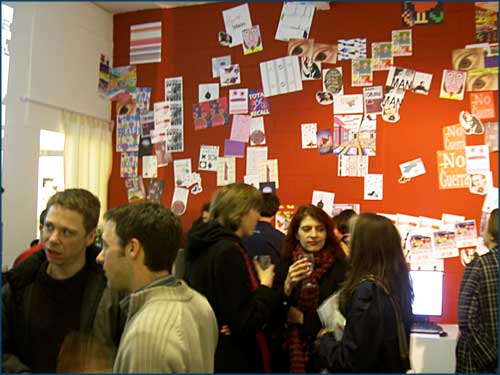
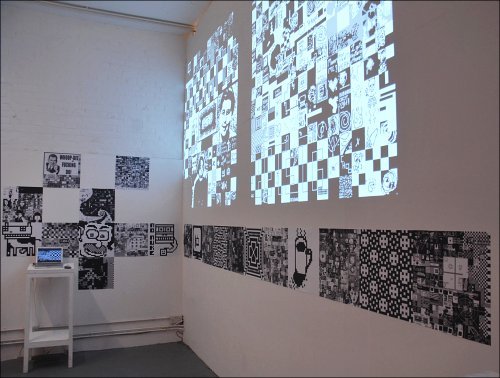
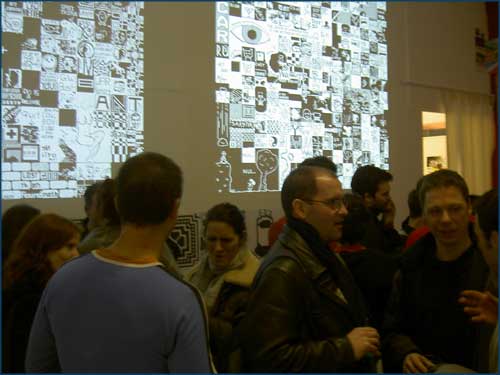
9 Dec 2005 – 23 Jan 2006
Press Release for print (pdf 920 KB)
HTTP presents Abuse of the Public Domain, the first solo show of networked media art by UK artist Stanza.
This exhibition features large-scale projections of 2 works, which use live real-time data from CCTV cameras sited in two cities, London and New York. Security tracking data is Stanza’s chosen medium for these process led artworks.
YOU ARE MY SUBJECTS uses data from a single fixed camera in NYC, focusing on subjects as they pass below it. AUTHENTICITY [Trying to imagine the world from everyone else’s perspective, all at once] draws its imagery from cameras all over London. Both works can be viewed in a web browser via the Internet and turn us all into voyeurs of eerie ‘parallel realities’.
“CCTV systems are everywhere in the public domain. Millions of hours worth of data are recorded every day by these cameras. We are all unwitting bit-part actors, in the filming of our own lives. Usually, we cannot watch, the results are not collected for broadcast back to the public. Rather they are monitored, filtered, distributed and archived without our knowledge or permission.
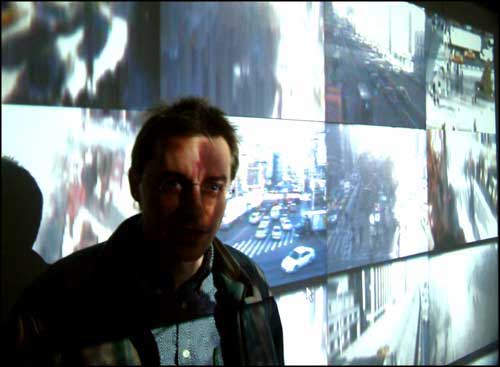
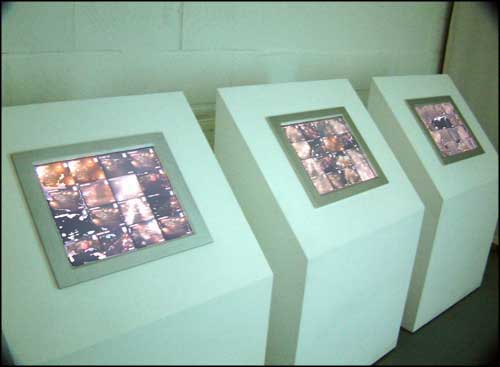
The city has millions of CCTV cameras. One can take the sounds and images off live web streams to offer them back to the public for new interpretations of the city. In essence, the city of London can be imagined as the biggest TV station in existence.”
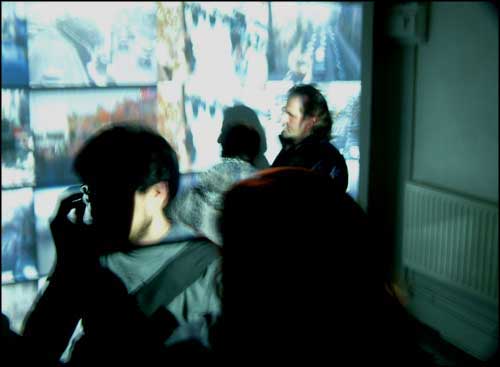
A full collection of Stanzas work will also be available for view in the exhibition via the new website. http://www.stanza.co.uk
About Stanza
Stanza is a London based British artist who specialises in net art, multimedia, and electronic sounds. His award-winning online projects have been invited for exhibition in digital festivals around the world, and Stanza also travels extensively to present his net art, lecturing and giving performances of his audiovisual interactions. His works explore artistic and technical opportunities to enable new aesthetic perspectives, experiences and perceptions within the context of architecture, data spaces and online environments.
Awards
Videoformes Multimedia First prize France 2005, Netsa Dreamtime 2004, Art In Motion V.First prize USA 2004, Vidalife 6.0 first prize 2003, Fififestival Grand Prize France 2003, New Forms Net Art Prize Canada 2003, Fluxus Online first prize Brasil 2002, SeNef Online Grand Prix Korea 2002, Links first prize Porto 2001, Videobrasil Sao Paulo 2001 first prize, Cynet art 2000 first prize, Dresden.
The archival material consists of extracts from: Moving Times – New Words – Dead Clocks, Project Sigma: a view of Counter Culture of the 1960’s; Spontaneous University Research; Antiuniversity of London; Free International School for Creativity and Research; A Collectography of Political Art and Distribution; State of Emergency; The Art School Scum.
The material has been collected by Emily Druiff between 2004/05 with assistance from Andrew Wilson and in discussion with members of the University of Openness and Independent Art School. The display of this material at HTTP is in response to current activities at the Hornsey School of Art, who between 29.10.05 and 19.11.05 are restaging the 1968 sit-in culminating in a conference on Art and Education.
The display of this material as part of the Distributed_Library is designed to further an enquiry into the issues of self-education. Visitors are welcome to take part in this research at HTTP and to consider ‘Is education Obsolete?’, ‘What would you change about your education?’ and ‘Is self-education a viable option for cultural producers?’ ‘How can this be made more practical?’. This research will suggest open source technology as a viable means for sharing and distributing information.
September 1st – 23rd October 2005
Theatre of Restless Automata by artist duo Boredom Research comprises three animated universes modelled from variations of the same computational formula. Each universe has a distinct aesthetic quality, which ranges from geometric abstraction to decorative figuration. Using computer algorithms based on scientific modelling techniques, the artists demonstrate how simple programming rules can create an infinite number of elaborate patterns. From these mosaics of pixels emerge small robotic figures (beings), which perform in a digital theatre of life.
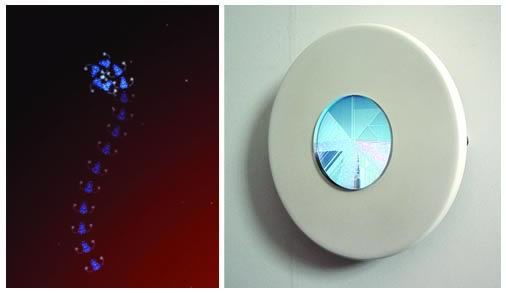
In RandomSeed Systems, groups of coloured pixels develop a pattern according to algorithms inspired by the mathematical model of cell growth known as Cellular Automata. The model designed by the artists produces patterns that evolve over time along an invisible grid of regular cells in a fashion reminiscent of tapestry weaving. The result is independent of the aesthetic control of the artists: a real computational creation.
A RandomSeed Event: see page online or download pdf.
A new work by boredomresearch, randomSeed Online [requires flash 8 plugin] launched on the 9th October 2005 at HTTP. For documentation of the artists’ research and a fully illustrated text of their talk please click here.
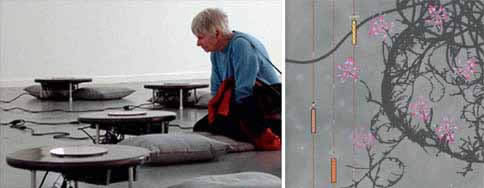
Biome systems consist of a set of glass portholes hung on the wall through which viewers can peer and observe virtual universes of swarming automata. Evoking a natural world of insects and micro-organisms, the artificial creatures evolve in sealed environments called Biomes, which span an acre of terrain. Limited by the two-inch diameter of the portholes, viewers can only catch a glimpse of the toing and froing of the biomes’ inhabitants.
Ornamental Bug Garden 001 features a formally arranged space, which is being colonized by simple mechanisms and plants created from the same algorithm. These colonies of bug like creatures are catapulted around the ornamental garden and sometimes collide with bubble pumping lifts. A sound piece is incidentally composed of the noise of these collisions.
boredomresearch are interested in building computational works, inspired by simple rules found in natural systems. They explore processes of computer modelling and the creative potential of genetic algorithms for the creation of nature-like phenomena.
Vicky Isley and Paul Smith have been collaborating as boredomresearch since 2000.
boredom research has produced a number of interactive sound applications, online projects and computational soundscapes. Their work has been recently shown at Transmediale.05, Germany; FILE04, Brazil; NOW festival 2004, Nottingham, Electrohype festival in Sweden, Garage festival in Germany, Database Media Event in Dublin and within online exhibitions such as VIDA 7.0 Art & Artificial Life International Competition, soundtoys.net, mobilegaze.com and Dots & Line online exhibition.
Ornamental Bug Garden 001 has been awarded an honorary mention in Transmediale 05, International Media Arts Festival, Berlin and VIDA 7.0, International A-Life Electronic Arts Competition, Madrid. Theatre of Restless Automata has been produced in collaboration with Aspex Gallery and Peterborough Digital Arts.
Theatre of Restless Automata has been produced in collaboration with Aspex Gallery and Peterborough Digital Arts.
‘Theatre of restless automata’ is a national touring exhibition commissioned by Aspex Gallery, Portsmouth in collaboration with HTTP House of Technologically Termed Praxis], London & Peterborough Digital Arts 2005/06. Supported by Arts Council England, South East & Southampton Solent University.
